#Carmen is called Linda in other countries
Explore tagged Tumblr posts
Text

I have a Teddy! Share your number if you want to be friends!
#Notes by Nikki#Animal Crossing#Pocket Camp#AC#AC: PC#video games#app games#I'm hoping that I can dress him correctly#PC has Bob (Eu)Gene and Louie#Carmen is called Linda in other countries#The closest that I can get to Tina is Tia
7 notes
·
View notes
Text
“Zsuzsa Roe” (Hungary 1971)
“Zsuzsa” had her fatal abortion in a Hungarian hospital as the law required. It was standard procedure to keep abortion clients for observation for a day after the abortion. Given the regulations meant to reduce the risk of maternal death, the abortion was most likely done in the first trimester. Unfortunately, even her country’s then-stringent safeguards and all the resources of a hospital would not be enough to save Zsuzsa’s life.
The abortion complication that killed Zsuzsa was recorded as “cardial insufficiency” with no further elaboration. It is unknown if she had a pre-existing heart condition that made the abortion more hazardous to her (similar to Carmen Rodriguez, Shirley Hollis, Maureen Tyke, Barbara May Hoppert, “Teresa Roe” or “Evie Roe”) or if she was healthy and developed cardiac complications entirely as a result of the abortion (similar to Linda Boom, Alesha Thomas, Anna Maria M., Jessie-Maye Barlow, “Carrie Roe” and “Anne Roe”).
“Insufficiency” may have also meant that she suffered other complications that when combined caused her heart to fail. Lack of oxygen, amniotic fluid embolism, air embolism, blood loss and more can result in or contribute to arrhythmia and/or cardiac arrest.
Zsuzsa was one of 34 pregnant people killed by legal abortion in the study period. All of them underwent their abortions in hospitals under what the study called “optimal conditions,” but even this wasn’t enough to save them.
#tw abortion#pro life#unsafe yet legal#pre roe legal#tw ab*rtion#tw murder#abortion#abortion debate#death from legal abortion#unidentified victim
4 notes
·
View notes
Text
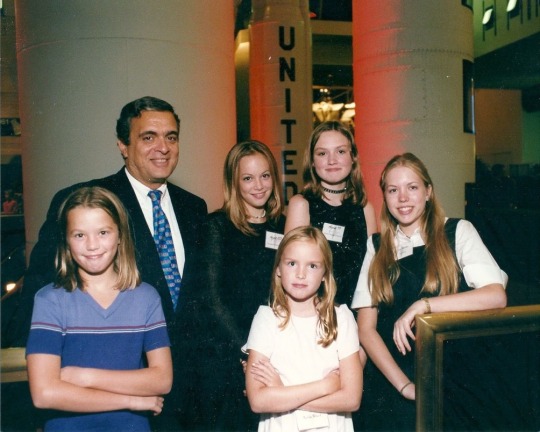


The “lemon drop kid”
Because of my father Butch Sheffield‘s position, he was able to invite his wife and his two daughters to the celebration party for the U-2 at the Air and Space Museum in DC in 1998.
My Dad proud of his Grandchildren asked Mrs. Tenant if she would ask the Director to take a picture with his five granddaughters.
It was at this celebration of the U-2 that Director Tenant started publicly talking about how valuable the U-2 was to America.🇺🇸
Explained George Tenet, director of the CIA, in a symposium on the U-2 in 1998:
From the U-2 data captured by our overflights, data corroborated by intelligence obtained by other means, President Eisenhower could confidently resist the fierce domestic pressure to engage in a massive arms buildup. He knew for certain, that we had no bomber gap and no missile gap with the Soviet Union, all Soviet boasting to the contrary. By any measure, that was an intelligence triumph. The men and women who worked long and hard and often took great risks for the U-2's early successes can be forever proud of that.
"I want to say a special thanks to the pilots," Tenet continued, "from Carmine Vito to the U-2 pilots of today. The courage that Carmine and his colleagues showed made an enormous difference to the security of our country. These men allowed generations of Americans to live in peace and prosperity.
Carmen Vito was the first man to fly the U-2 over Moscow on July 4, 1956. Later on in the year of 1956. He was on another mission over the Iron Curtain when disaster almost struck. Vito was called by his fellow, U-2 pilots the ‘Lemon Drop kid.” He was known to always have a bunch of lemon drops in his pocket. Although he wasn’t supposed to he would open his face plate while flying and pop a lemon drop in his mouth. This time he accidentally popped an L pill into his mouth. He thought this was a strange lemon flavor. He opened the face plate again and spit it out. The L pill contained potassium cyanide. The poison pill was an option that U-2 drivers were given while flying over enemy territory.
The only reason why they were given this pill was so they could make a decision before being captured by the enemy, if that were to happen.. if they wanted to end their life to avoid the torture that was certainly coming.
It is a false rumor that U-2 pilots were ordered to kill themselves. After thIs flight, it was decided to destroy the L pills and look for a better idea. The better idea was a needle inserted in a silver dollar if you pulled the needle out it was covered with an extremely deadly shellfish toxin. They called it the dollar….only one poison needle coin was made. It was thought if a pilot had to use it because of capture, there would probably not be any more flights.
In October 1962 the CIA turned the U-2 program over to the Air Force. The Russians had promised that they would not place ballistic missiles on the Communist island of Cuba. One of our U-2’s flew over Cuba, and found that they were indeed lying, and that the missiles were there …only 90 miles from Florida. This caused one of the most terrifying times in American history as we negotiated with Russia/ Soviet about solving the threat of the ballistic missiles. During this terrifying time Major Rudolph Anderson, while flying a U-2 was shot down over Cuba, and he not survive the attack. It was later found that Premier Khrushchev did not order the shoot down. To make it even worse one of our U-2 in a separate division was flying over the North Pole, his navigation failed and he flew into Russian territory. President Kennedy and Premier Khrushchev were able to get through these disasters without starting World War lll, The Soviets removed their missiles from Cuba. We removed our missiles from Turkey and Italy. It was agreed that a red phone would be placed in Moscow and Washington DC to make sure any further disturbances could be discussed in a timely manner.. by Linda Sheffield
@Habubrats71 via x

2 notes
·
View notes
Text
[mane]
pairing: mentioned! nora + michael / michael + gina warnings: language, alcohol, smoking summary: one of the many series five, ep two versions i have (this is pre-timeline nora because i started writing it about three years ago but i genuinely have nowhere to put it now because this isn't at all how i'd handle the scene at all). word count: 0.7

“look, i don’t want to hear another fucking thing about mosley. that man is a danger to this country, but,” he braces himself whilst stubbing out the cigarette. “jimmy mccavern is an immediate threat to us.”
thomas’ eyes dance around the dimly light room hidden at the back of the garrison, watching each and every member of his family stare intently with varying degrees of distaste and discomfort. “the tory-bastard has all eyes on him; mccavern is a protestant hooligan in over his head that nobody gives two fucks about. glaswegians don’t do suits; they don’t do politicians and they don’t do family meetings. they use their fists, their rage.”
the atmosphere felt tense, bleak and unbreakable despite everyone being surrounded by loved ones. polly and ada were cornered off to the side mumbling amongst themselves. occasionally an contradicting remark would slip from the matriarch followed by a giggle and had she wanted thomas to have heard, arthur would’ve chuckled. shelby boys were spread between, as was charlie, johnny and isaiah.
“i say, we go to glasgow, their territory – their shithole. pol’s even set us up with acquaintances.”
she scoffs rolling her eyes. “if you’d call it that.”
michael glances to his mother, feeling his eyes narrow on their own accord. glasgow meant trouble and trouble in glasgow was the last thing he needed.
“our contact runs a pub like this one and is somewhat of a figure head of the norman conks. they live in brigdeton – yes, the same place the billy boys are from before you ask finn.”
“he’s got a son, a missus and an older sister who operates in said gang and in the taylor’s inn pub. father is scottish and mother was originally born in calais.”
“you said, taylor’s, didn’t you?”
“yes.”
“the mother, you got a name?”
“no.”
“oh, i do.” johnny smirks, before continuing. “name’s carmen taylor, married colin mcleod, beautiful ceremony – a lot like your john’s – anyway that was 1901 up in gretna green. then…”
“-you goin’ anywhere with this fucking story?”
“1903 strolls around, as does baby number three. wouldn’t you believe she’s once sat in this very room.”
michael sighs, attempting not to beat johnny to the punchline with gina sitting within his peripheral.
“our nory.”
the room falls into a unanimous confusion. “you’re dealing with nora’s fucking family tommy.”
“i don’t see how that problem pertains to the rest of us michael.” thomas states rather nonchalantly. “you dug that grave.”
polly snorts at her nephew’s blatant hypocrisy, earning herself a few contentious looks from him and the other women occupying the space. any of them could’ve been in that position, particularly linda. the shelby men left behind a trail of dead, deserted and abandoned wives, any of the remaining would be next on the chopping-block.
“alec’ll have your fucking head kid.” arthur mutters, patting his cousin on the shoulder when passing behind him to pour another drink from the bar. “can’t speak for tom or finn, but if that was lovely ada and fred–“
“arthur.” michael warns, “not here.”
michael’s sudden sharpness intrigues thomas, as he watches the boy fidget in seat not knowing quite where or what to do with his hands and the conclusion being rather obvious with his disposition. “have you neglected to mention this to your new wife?”
perplexed, gina’s tilts her head pouting at her husband who was now pulling out his cigarette tin.
she’d assumed this nora her in-laws spoke of was simply a jilted ex-girlfriend michael had left behind and that her family didn’t take too kindly to his sudden departure nor his return.
“george’d be what? five–six? starting primary school and making friends of his own.” thomas jeers, “and little rosalin she’d be–“
“–three.” michael mumbles into the straight as he attempts to light it. “the fuck’s your point? i wasn’t there, alright?”
“my point michael,” thomas punctuates. “is that it was carless, reckless and because you lack any fucking fundamental sense of initiative and responsibility you’ve once again ended up with a mass amount of collateral that we’re – as a family, having to clean-up.”
“where are they?”
“glasgow. scattered.”

again, like i said this was written quite a while ago and at that point the mcleod's and shelby's had never met, let alone had reoccurring engagements.
also back then thomas had faked michael's death after nora purposely left him so she wouldn't go looking for him when in actual reality michael is more of a flight risk and thomas didn't want him coming back knowing he'd be more likely to find nora than the vice-versa.
i switched it because for all his faults (and theirs as a couple) i truly don't think michael would've gotten remarried if he knew nora was still around. do i think he would've cheated on her? absolutely but at the very least the threat of the legal system would've stopped anything past that.
nora and the kids obviously aren't dead with thomas, polly and ada being the only ones aware of the truth. but that's initally why i wrote michael shitting himself a little because in the older version he was going to have to face nora and her volatile family.
3 notes
·
View notes
Text
July 4 ZODIAC
An agreeable climate is the first and most significant state of bliss for that individual. Since they are incredibly touchy, with extraordinary strength and diligence, albeit very aloof. However long they conquer that lack of involvement, they can accomplish extraordinary action, show significant capacities, and achieve significant power. Fit for carrying on with work, they appreciate logical investigations and show strict inclinations. They likewise show critical expertise in manual work. They stay consistent with their life standards and objectives: they can be extremely cautious, far-located, and parsimonious. They are much of the time considered ravenous for that. Steady and persevering: they could in fact be savage. They have serious areas of strength for an of their own distinction, yet they frequently have next to no solidarity to show it throughout everyday life. His incredible aversion to mind-sets is joined with exceptional ambiguity. They likewise tend to dejection and experience influxes of despairing, with frequently damaging inclinations. It ought to be added that they are by and large intense, pleased and merciless individuals, with little respect for other people. What would it be advisable for them to desire? To assume command over their negative impulses that push them towards mercilessness. In the event that they can't do that, they could be in danger for life perils. What compromises them? Allow their foes to sort out against them, which will make them bomb in the last piece of their lives.
July 4 ZODIAC
Assuming your birthday is July 4, your zodiac sign is Disease
fourth of July - character and character character: astute, genuine, enthusiastic, touchy, proud, fastidious calling: dramatist, author, spy tones: cream, brown, beige stone: lapis lazuli creature: slug plant: Spiderwort plant fortunate numbers: 2,21,33,46,53,57 very fortunate number: 15 Occasions and Observances - July 4 Argentina: Public Day of Conjunction and Majority of Political Articulations, honoring the notable goodbye message to the late Leader of the Country General Juan Domingo Perდ³n conveyed by Dr. Ricardo Balbდn. Colombia: Illustrator's Day. Mexico: Acდ¡mbaro, Guanajuato. Supporter Holy person Celebrations out of appreciation for the Virgin of the Asylum of Miscreants. Venezuela: Planner's Day. Argentina: Rustic Specialist's Day, honoring the introduction of Dr. Esteban Maradona. US: Autonomy Day. fourth of July VIP Birthday. Who was conceived that very day as you? 1902: Meyer Lansky, Jewish-American mobster (d. 1983). 1907: Gordon Griffith, associate chief, film maker and American entertainer (d. 1958). 1910: Gloria Stuart, American entertainer, who played the elderly person in the film Titanic) (d. 2010). 1911: Mitch Mill operator, American artist (d. 2010). 1914: Roberto Escalada, Argentine entertainer (d. 1986). 1917: Manolete, Spanish matador (d. 1947). 1918: Taufa'ahau Tupou IV, Tongan ruler (d. 2006). 1921: Gდ©rard Debreu, French market analyst (d. 2004). 1922: Guillaume Cornelis van Beverloo, Dutch painter and printmaker (d. 2010). 1923: Bernard Loomis, American toy engineer (d. 2006). 1924: Eva Marie Holy person, American entertainer. 1925: Cathy Berberian, American artist lyricist (d. 1983). 1926: Alfredo Di Stდ©fano, Hispanic-Argentine soccer player and mentor (f. 2014). 1927: Gina Lollobrigida, Italian entertainer. 1927: Watts Humphrey, American PC researcher (d. 2010). 1927: Neil Simon, American essayist, maker and screenwriter. 1928: Giampiero Boniperti, Italian soccer player and chief. 1929: Darდo Castrillდ³n Hoyos, Colombian Ecclesiastical overseer (d. 2018). 1930: Mohamed Demagh, Algerian stone worker. 1931: Stephen Boyd, English entertainer (d. 1977). 1931: Sდ©bastien Japrisot, French producer (d. 2003). 1933: La Prieta Linda, Mexican artist and entertainer. 1934: Carmen Santonja, Spanish artist and arranger, of the couple Vainica Doble (f. 2000). 1935: Narciso Ibდ¡nez Serrador, Spanish theater chief. 1935: Dunav Kuzmanich, Chilean producer, scriptwriter and librettist situated in Colombia (f. 2008). 1937: Sonja Haraldsen, Norwegian blue-blood. 1938: Bill Wilts, American vocalist. 1939: Manuel Summers, Spanish producer (f. 1993). 1940: Miguel დ?ngel Estrella, Argentine musician. 1941: Hugo Henrდquez, Ecuadorian artist (d. 2012). 1941: Sergio Oliva, Cuban weight lifter (d. 2012). 1943: Alan Christie Wilson, American artist, of the band Canned Head (d. 1970). 1948: Renდ© Arnoux, French Equation 1 driver. 1949: Pedro Antonio Martდn Marდn, Spanish government official and financial specialist. 1949: Horst Seehofer, German lawmaker, serve leader of Bavaria. 1952: დ?lvaro Uribe, Colombian president somewhere in the range of 2002 and 2010. 1959: Victoria Abril, Spanish entertainer. 1960: Roland Ratzenberger, Austrian Recipe 1 driver (d. 1994). 1961: Ana Acosta, Argentine entertainer and humorist. 1963: Ute Lemper, German vocalist. 1965: Horace Award, American b-ball player. 1967: Vinicio Castilla, Mexican baseball player. 1969: Martin Schmidt, German judoka. 1969: Elena Arzak, Spanish cook. 1970: Alberto Ardines, Spanish drums, of the groups Avalanch and Sauze. 1970: Tony Vidmar, Australian footballer. 1971: Koko, a gorilla prepared to speak with signs. 1972: Nina Badriე‡, Croatian pop vocalist, agent of Croatia in Eurovision 2012. 1972: Marcel Curuchet, Uruguayan performer, from the band No te Va a Gustar (f. 2012). 1972: Alexდ©i Shდrov, Latvian chess player. 1973: Camui Gackt, Japanese artist, of the band Noxiousness Mizer. 1973: Jan Magnussen, Danish motorsport driver. 1973: Ana Marდa Orozco, Colombian entertainer. 1975: Tania Davis, Australian violist, of the Bond band. 1976: Daijiro Kato, Japanese bike racer (d. 2003). 1978: Emile Mpenza, Belgian footballer. 1978: Becki Newton, American entertainer. 1979: Renny Vega, Venezuelan soccer player. 1980: Marc Lieb, German motorsport driver. 1982: Vladimir Gusev, Russian cyclist. 1982: Hannah Harper, English pornography entertainer. 1983: Miguel დ?ngel Munoz, Spanish entertainer. 1983: Miguel Pinto, Chilean soccer player. 1984: Jazmდn De Grazia, Argentine model (f. 2012). 1985: Wason Renteria, Colombian footballer. 1988: Angelique Boyer, French-Mexican entertainer. 1990: Fredo Santana, American rapper (f. 2018). 1992: დ"scar Romero Villamayor and დ?ngel Romero Villamayor, Paraguayan footballers. 1995: Bautista Merlini, Argentine soccer player. 1999: Moa Kikuchi, model, entertainer, vocalist and Japanese artist.
0 notes
Text
Subtext and Culture, Young Royals, Season 1, Episode 2
Episode 2 picks up the morning day after the initiation party, the girls are having breakfast lunch at their dorm, the boys at theirs, and everyone wants the juicy details about what happened at the party...
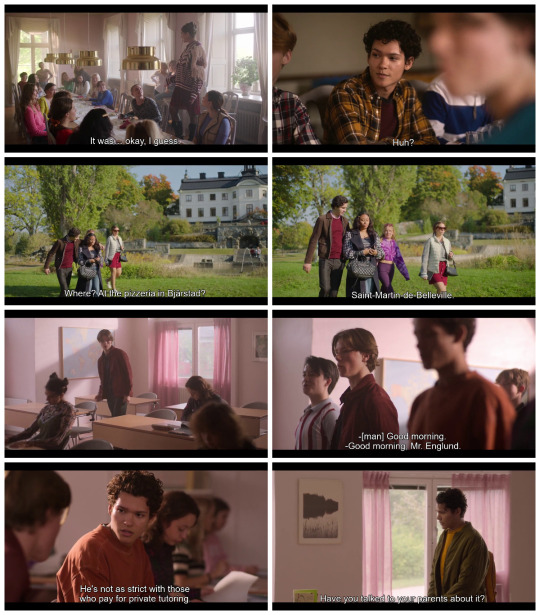
Culture: Tell me more, tell me more, did you get very far? Although, it's pretty funny how the roles are reversed, Maddie is all "meh" about it, while Nils tells a different story. Then again, since when do you get together after a blowjob?
Culture: I actually have no idea why Simon is having breakfast at Skogsbacken, since regular schools only cover lunch for students, everyone eats breakfast at home, and then goes to school. Then again, it allows a scene where (Never mind, they're having lunch, thanks @kamand !) Blink and you miss it: Wilhelm casts some nervous glances at Simon after having been called out for disappearing at the party and almost forced to confess to making out with someone.
Culture: I know Felice is trying to put August down, but don't knock a proper Swedish pizza! As much as I like living in the US, they can't fucking make pizzas here, and the first thing I eat every time I go back to Sweden is always a real pizza. With pineapple and shrimp as God intended pizza to be made!
Culture: August is namedropping ski resorts in the Alps, which is where you go skiing in Europe if you have money, although Saint-Martin-de-Belleville is actually near Val Thorens in France, while Verbier is in Switzerland. It does have a three-star restaurant, though. Sweden and Norway have a couple of decent ski resorts, but the Scandinavian mountain chain is simply not as impressive as the Alps.
Subtext: Remember Wilhelm getting up and hurrying to math class in the beginning of the scene? It was so he could grab the other seat next to Simon, because he knows Simon is gonna sit next to Sara, since no-one else does.
Culture: Formally greeting your teacher before class is very uncommon in Sweden, but since Hillerska is all about discipline and tradition, of course they do it. Note that they're again using the formal Swedish title for male teachers, Magister, which in a regular school would be kind of a joke, since teachers and students are on a first-name basis with each other.
Subtext: Wilhelm is exposing how the world works if you have money. At Simon's old school, studying alone would result in good grades, but Hillerska is slightly corrupt and almost expects the students to essentially pay for getting a good grade.
Subtext: Simon is lying to his teacher, he absolutely hasn't talked to his parents about paying for private lessons.
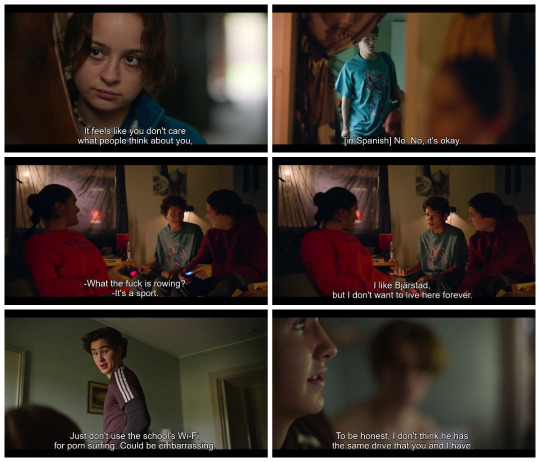
Subtext: No, Sara absolutely does care about what other people think about her, and when she directly tells Felice that she would actually like some friends, that's when Felice gets it and starts making an effort to become real friends with her.
Culture: They're all bilingual at Simon's home, they're all speaking Spanish and Swedish, although Linda has a very noticeable accent to her Swedish. Based on demographics and statistics, the most likely scenario is that Linda immigrated to Sweden from Chile, met Micke, and started a family. In real life, Omar Rudberg was born in Venezuela and grew up in Sweden, while Carmen Gloria Pérez was born in New York, and grew up in Puerto Rico.
Subtext: Remember how I talked in the intro post about how distant social classes know nothing of each other? Ayub and Rosh are either working class or lower middle class like Simon, and since rowing is a typical upper class sport, they know nothing of it, they don't even think of it as a real sport. Unlike football, which is a proper working class sport, they know all about that!
Subtext: Scandinavia has Jantelagen, and everyone there thinks it's uniquely Scandinavian, but all countries have some form of Tall Poppy Syndrome. In this scene, Simon is starting to make a class journey, he started rowing, he started trying to fit in with the other upper-class kids, and getting into a relationship with someone as upper-class as Wilhelm would definitely move him all the way. But going on a journey means leaving things behind, which is why Rosh and Ayub are cutting him down and literally turning their backs on him. They like it in the small town of Bjärstad, why can't he be happy there too? Why is he betraying his roots?
Subtext: This comment from August nicely foreshadows a later episode when August does something traceable on a School computer...
Subtext: What August means is that he's not sure Wilhelm has the same desire to be accultured into the upper class, to play the part of a proper prince, in the same way that he and Erik have accepted their roles and are even enjoying them.
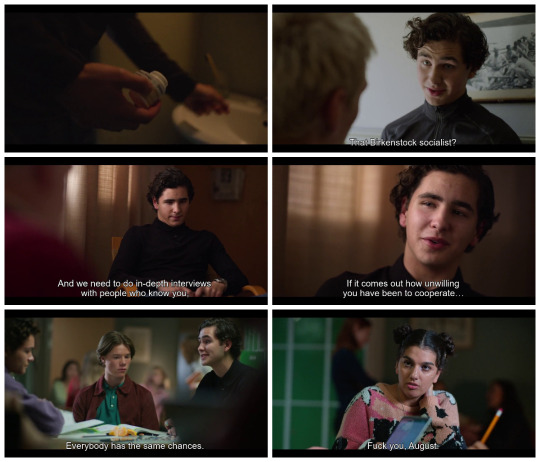
Culture: Although it's impossible to read the name of the medicine, the paper tag on the bottle indicates that it's some kind of prescription medicine. From the conversation with Vincent, we learn that it's some kind of ADHD medication, probably some kind of Dextroamphetamine since those improve athletic ability and cognitive functions in healthy people.
Culture: Birkenstock sandals are associated with hippies in Sweden as well as in many parts of the world, so August is actually saying that the school counselor isn't really part of the same upper-class society as the rest of the staff. And again, his use of the word sosse drives the point home.
Subtext: Consequently, the counselor sees right through August and refuses to immediately prescribe him the medication that he wants...
Subtext: ...even though August tries to both bribe him and threaten him into giving him the medication he wants.
Subtext: A big theme of this episode is class journeys, and in this scene and a previous exercise scene, August gushes about how good a thing that is, how proud he is of Simon for going on one, and spouts some crap about how everyone can make it if they really want to.
Subtext: Thankfully, Madison says what we're all thinking: August is full of shit, life isn't fair, and they're only at the school because they were born into privilege.

Blink and you miss it: After Wilhelm has nervously texted his crush for the first time, he starts to bite his fingernails, but quickly stops himself, because why would he be nervous? He's just texting another boy about rowing practice, there's nothing more to it!
Subtext: Simon's texting game is on point though, he knows exactly what he should write to get Wilhelm to go on a totally-not-a-date with him.
Subtext: In the same way that August couldn't convince the counselor about being sick, I don't think Wilhelm's atrocious acting here convinces August that he's sick either.
Culture: Public transport in the greater Stockholm area - or wherever we're supposed to be - is of course cash-less, and you pay by either charging a special card, or by signing up in their app and buying tickets through there. The point of this scene though is to drive home how Wilhelm has never ever had to take the bus before in his life, and therefore has no idea how it works.
Culture: The totally-not-a-date starts at a Circle K, which in Sweden is just another gas station, but it is actually a Canadian multi-national convenience store corporation. The price of gas is of course posted in kr/l, and 13.98kr/l corresponds to roughly $6/gal.
Subtext: Throughout the totally-not-a-date, Wilhelm is trying to reach for common ground with Simon, trying to show him how he's just a regular guy...
Subtext: ...but then real life intrudes, Wilhelm is recognized by some local girls, who call out to him and run away giggling, which shows how he's not a regular guy, he's going to get recognized wherever he goes.
Culture: Kokt eller grillat, boiled or grilled, are the two ways you can get your hot-dog at pretty much any hot-dog place in Sweden, and ketchup and mustard is always offered. The correct answer to this question is of course grilled, with ketchup and mustard, and this just shows that Wilhelm is a man of culture and good taste. Unfortunately, they were out grilled ones, so they all got boring soggy boiled hot-dogs instead. Is there a metaphor here? I don't know.
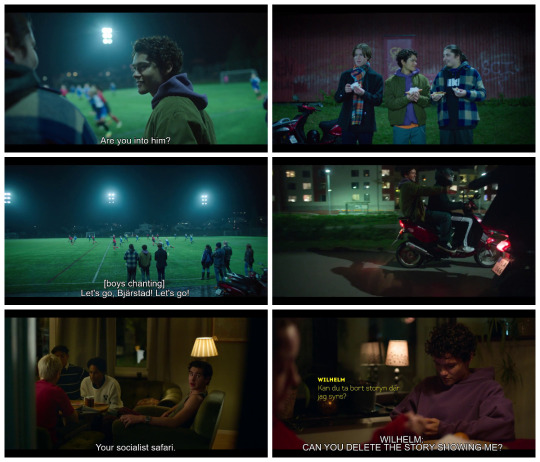
Subtext: Again, the show drives home the point that absolutely no-one has a problem with people being gay. Simon is clearly out to Ayub and the rest of his friends, and Ayub immediately picks up on the fact that this is totally a date.
Blink and you miss it: Ayub nudges Simon with his elbow to tell him that he should make a move on Wilhelm.
Culture: What we're looking at is just the local junior/high school football team, Bjärstad, playing a match against some other unnamed junior football team. Since the stakes are super low, the audience basically consists of whichever parents and friends of the players that could be bothered showing up.
Culture: Driving age is 18 in Sweden, and even then getting your own car at that age is extremely uncommon. However, you can easily get a license for a moped when you turn 15, so these are the vehicles of choice for teenagers to get around.
Subtext: August found out about Wilhelm's trip to town, but his main problem with it is that he wants Wilhelm to stop slumming it with lower class people, and to start hanging out with everyone at school instead, so that he can be properly accultured into the upper class. Again, sosse in this context means working class, not socialist.
Subtext: Although Simon felt really great about his first date with Wilhelm, the text message reminds him that Wilhelm isn't a regular person, and that even this innocent little trip generates interest and scrutiny, and can't be posted publicly.
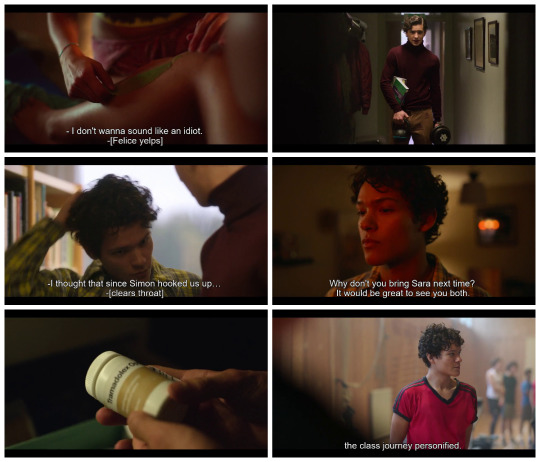
Culture: As everyone should have noticed by now, Madison keeps speaking English, while everyone speaks to her in Swedish, so clearly she understands it. But here she gives her motivation for sticking to English, and that is that she doesn't feel she's good enough at speaking Swedish. Boarding schools like Hillerska attracts international students that have some kind of connection to the country, so a likely scenario is that Madison grew up in the US with a Swedish parent, and she's being sent here to experience Swedish culture and get immersed in the language to learn it better.
Cinematography: This shot of August drives really home all the pressure he is under, he's out of drugs, the headmistress just hinted that he's out of money, and he's literally being weighed down by books and work-out weights.
Subtext: Simon has kept his visits to Micke a secret from Sara, so here he has to intervene to make sure August doesn't accidentally reveal this to her. He also wants to protect his sister, so he's redirecting August's search for drugs onto himself.
Subtext: And on the flipside, Simon isn't really telling his dad that Sara still hates him and really doesn't want to see him, so he's vague when Micke asks about Sara and Linda.
Culture: Finally a bottle of medicine where we can read the label! Unfortunately for Simon, this is Tramadol, an opiate prescribed for pain relief, which is the complete opposite of the kind of drugs August wants.
Subtext: If you haven't figured out yet that this episode is about class journeys, August spells it out for us here. However, the reason he's "congratulating" Simon in front of everybody is because Simon just supplied him with more drugs, so this is his way of thanking him, since he can't really pay him.
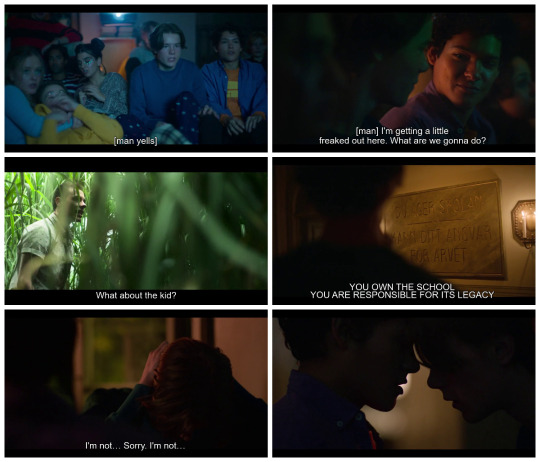
Blink and you miss it: For a split second, Wilhelm grabs Simon's leg during the scary scene.
Subtext: The entire dialogue of the movie works as subtext for what's actually going on between Wilhelm and Simon at this point, and Wilhelm is getting a little freaked out by this sneaky display of affection.
Subtext: The movie also puts words on the implications of Wilhelm getting together with a boy, what about having kids in the future? Can you carry on your family name and traditions, or will they die with you?
Lost in translation: The plaque actually says "FEEL YOUR RESPONSIBILITY FOR THE HERITAGE". Even though the plaque means the heritage and legacy of the school itself, Wilhelm is thinking about his legacy, his heritage, and how getting together with Simon would threaten that.
Lost in translation: Wilhelm actually says "jag är inte en..." - "I'm not a..." before he stops himself. So it's not possible that he was trying to say "I'm not gay", because that doesn't work grammatically in Swedish either. He could be trying to say "I'm not a guy like that" or "I'm not a guy who likes guys", that would work.
Cinematography: The framing and silhouetting of this shot is just chef's kiss. The outline of their hair allows us to see who is who, and we can see from their poses that Simon is welcoming a kiss, while Wilhelm is still hesitating.
489 notes
·
View notes
Text
CHICANO ART MOVEMENT reviews PST: LA/LA Attended Programming (1 of 3) 2018
via Pacific Standard Time
Pacific Standard Time: LA/LA is a far-reaching exploration of Latin American and Latino art in dialogue with Los Angeles. Led by The Getty, it involves more than 70 arts and cultural institutions across Southern California, from Los Angeles to Palm Springs, and from San Diego to Santa Barbara, and runs from September 2017 through January 2018.
The thematically linked exhibitions and programs of Pacific Standard Time: LA/LA highlight different aspects of Latin American and Latino art from the ancient world to the present day. With topics as varied as luxury arts in the pre-Columbian Americas, 20th-century Afro-Brazilian art, alternative spaces in Mexico City, the mural tradition, and the boundary-crossing practices of Latino artists, exhibitions range from monographic studies of individual artists to broad surveys involving countries throughout Latin America.
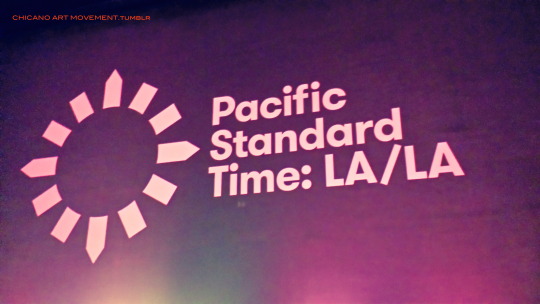
Pacific Standard Time: Latin American & Latino Art in LA (PST: LA/LA)
CAM:
Our introduction to the Pacific Standard Time initiative was in 2011 when we attended Pacific Standard Time: Art in L.A. 1945-1980 and its functions. At that time we mainly focused on the L.A. Xicano segment between Pacific Standard Time and the UCLA Chicano Studies Research Center that brought “forward an astounding array of little seen works that broaden the historical record, but it also places these works into a dynamic dialogue with artistic practice today.” After contemplating over events and exhibitions pertaining to American artwork from the iconic years of the Chicano Art Movement, the PST experience had us intrigued for what was to come in the next series of occurrences.
With time to reflect on our initial observations of the Pacific Standard Time: Art in L.A. 1945-1980 and events before the next initiative. CHICANO ART MOVEMENT blog prepared to share our perspectives and closer examine the drive when the succeeding “ambitious exploration of Latin American and Latino art” affair would return in 2017, this time titled Pacific Standard Time: Latin American & Latino Art in LA (PST: LA/LA). This measure was proposed to showcase a broader perspective, including pre-Colombian era, 20th century to Afro-Brazilian art; modern, contemporary to ancient world, pre-modern era, “and boundary-crossing practices of Latino artists.” We were also motivated to gather specific knowledge for exploration in our studies from this creative effort.
With over 150+ PST: LA/LA exhibitions and planned events to choose from, we had the opportunity to visit 18 in total, mainly located in Southern California. During this series we will explore our perspectives on the artists, artwork and programming for this “far-reaching exploration of Latin American and Latino art dialogue with Los Angeles” we considered during the enterprises run.
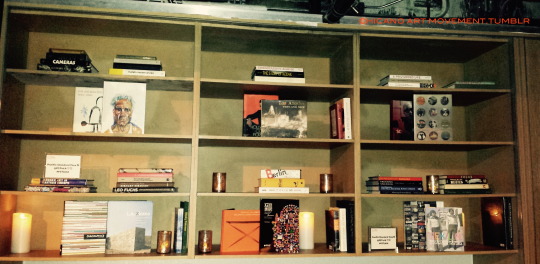
(Detail of: art catalogs displayed behind bar at Neue house for the Pacific Standard Time: LA/LA Countdown Celebration 2017)
The initial PST: LA/LA related event we attended was an invitation to the Pacific Standard Time: LA/LA Countdown Celebration in January of 2017 at the NeueHouse in Hollywood, California. This event was highlighted as “a cocktail reception and special performance by Ceci Bastida to celebrate the countdown.” During the evenings reception Pacific Standard Time affiliated speakers took the podium to inform celebration guests on what had been planned for PST: LA/LA. Visuals broadcasted on different screens throughout the expansive venue offering information with images and video. This is how we became more informed on the associated artists and upcoming program scheduling. Along with the array of visual and sonic mediums that would be showcased in a multitude of venues across California. Attending also allowed us insight on the amplitude of Pacific Standard Time: Latin American & Latino Art in LA and the support there was for the large scale attempt to educate on the many different cultures of Latin American & Latino Art in LA to the masses for an enriching learning experience.
A few of my personal highlights from the night’s celebration included talking with artists and curators we recognized in attendance and, with the odds in our favor, it earned us an amusing offhand conversation with a notable Chicano scholar. Another was the interactive PST: LA/LA photo booth where we took Pacific Standard Time: LA/LA Countdown Celebration 2017 themed photos. And not to forget the reveling over the bite sized Latin American cuisine classics along with complimentary cocktails for the night.
Read our full write up on this event as: CHICANO ART MOVEMENT attends: Pacific Standard Time: LA/LA Countdown Celebration 2017.
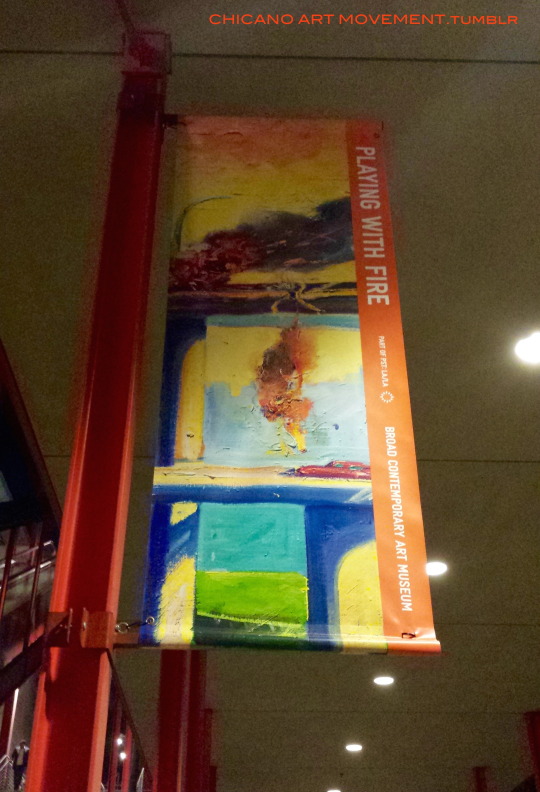
(Banner for Carlos Almaraz “Playing with Fire” exhibition at LACMA)
Starting off our first visual art experience related to PST: LA/LA occurred during our visit to the Los Angeles County Museum of Art’s (LACMA) long running “Muse ‘til Midnight” function. The August 2017 gathering explored the 90′s backyard party theme but with an adult twist. DJs spun tunes on different floors of the Broad Contemporary Art Museum (BCAM) and at the entrance to the party through out the night. The gathering included the after hours viewing of “Chagall: Fantasies for the Stage,” and three Pacific Standard Time: LA/LA Latin American & Latino Art in LA exhibits in a festive nocturnal atmosphere.
Once on the LACMA campus we first decided to view what was a visually romantic curated exhibition which highlighted “the principal role that music and dance played in Chagall’s artistic practice.” After immersing ourselves in the ocular beauty that was “Chagall: Fantasies for the Stage,” we exited the Resnick Pavillion and walked across to BCAM and up to the third floor to view “Home—So Different, So Appealing.” Which was the beginning of our PST: LA/LA survey trifecta at the museum. Anita and I absorbed the melding of visual art and music in the galleries while we moved through different floors in the building.
As we did our walk through of “Home—So Different, So Appealing” I contemplated over the abstract familiarity of artworks included in the exhibition. The mission of the show was to “explore one of the most basic social concepts by which individuals, families, nations, and regions understand themselves in relation to others— the idea of home.” Large scale artworks like artist Daniel Joseph Martinez’s “The House America Built” took center real estate in the galleries. While impressive artworks like Mexican born artist Solomon Huerta’s large prismatic paintings adorned the gallery walls. Along with many other artists and mediums included from around the world. The piece I studied most in detail was Carmen Argote’s “720 Sq. Ft. Household Mutations, Part B, 2010.” The work was “carpet, paint, and velcro (carpet from the artist’s childhood home).” I was unexpectedly lured in by the contours in the massive hanging and mostly rolled up rug for closer inspection. Contemplating on Argote’s piece, I pondered on the ideas Carmen wanted to leave the viewer. This one left me with the essence of familiarity that is home.
After moving on from our observation of “Home—So Different, So Appealing,” we then took the elevator to the second floor of the Broad Contemporary Art Museum (BCAM) to experience the story of “Playing with Fire” Paintings by Carlos Almaraz would further tell us about the Chicano creative. This was a highly anticipated PST: LA/LA exhibition for us to attend during the run of the initiative. We had learned of this display coming to fruition years before when a call through the Chicano networks was put out in search of forgotten and rarely seen artworks by the Chicano master in private collections. Works were being sought for a large scale retrospective which aim was “to reconsider the artistic achievements of Carlos Almaraz in a broader context than was generally accorded in his lifetime.” And with backing of Chicano notables like actors Richard “Cheech” Marin, Richard Montoya and UCLA Chicano Studies Research Center’s Dr. Chon Noriega, many pieces came out the woodworks for the bravado display from the artist oeuvre. This exhibition along with the catalogue narrated the thought provoking triumphs and tragedies of an artist who left his brilliant brush mark on this earth.
The third and final stop at BCAM and our the last PST: LA/LA associated observation for the night was a walk across the gallery where “Playing with Fire” was exhibited and into “A Universal History of Infamy.” This complex exhibit featured “new works from boundary-defying artists who adopt methods from anthropology, theater, and linguistics.” A visually strong piece was Vincent Ramos’ “Ruins Over Visions or Searchin’ For My Lost Shaker of Salt [Ante Drawing room].” Mr. Ramos had created what appeared to be a wooden shack like structure that inside housed what looked like a showing of ephemeral American, Chicano and Mexican images under plexiglass, like magazines, photos and music in a clubhouse type manner. I experienced the progression and flow walking in and around it locating bits and pieces that would trigger a reminiscent provocation of thought. The work had recalled memories of constructing fort-like structures from reclaimed backyard items with my friends as a kid.
Read our full write up on this event as: CHICANO ART MOVEMENT attends: Muse ‘til Midnight at LACMA - 2017.
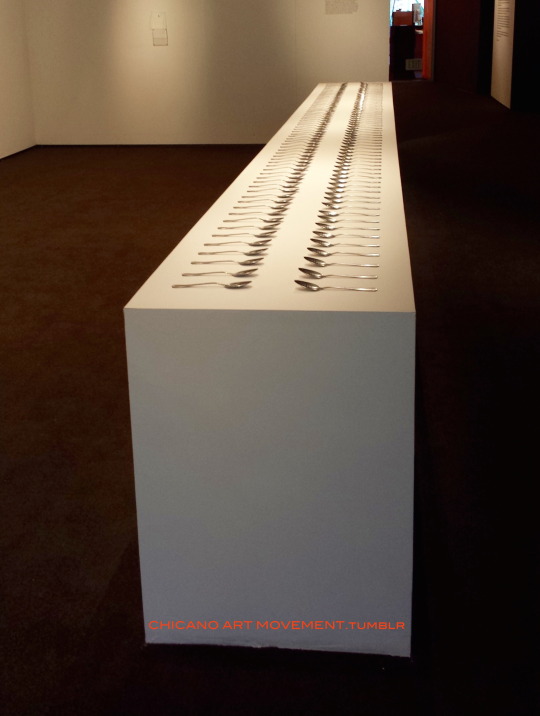
(View of Reynier Leyva Nova’s “S.O.U.P” installation.)
In mid September 2017, we traveled to PST’s exhibit entitled “Deconstructing Liberty: A Destiny Manifested” at Muzeo in Anaheim, California. From the Promenade Street museum entrance, we were first greeted by the staff and then by exhibit’s introduction written by curator Marisa Caichiolo. It explained that this was a collection of fourteen artists from eight countries of the western hemisphere. The first of the artists that we came to focus upon was Chicana Linda Vallejo. Her work “The Brown Dot Project” was inclusive of previously collected data about Latinos that was reformatted into familiar figures and symbols reaffirming the Latino presence is found in every sector: from health and employment to populations statistics and economic impact within the United States. Vallejo accomplished her vision by using geometric abstraction giving two distinct versions of each piece: up close and at a distance.
As we progressed and opposite to Vallejo were the works by Cuban artist Reynier Leyva Nova. His installation piece entitled “S.O.U.P. (Survival Object Under Pressure)” consisted of 272 engraved spoons with words from various political activists. While reading, I understood the creative’s point that these words continue to be revered, repeated, and remised.
Proceeding further into the exhibit, we heard ocean wave sounds and I focused in on the two miniature docks opposite from one another but tethered together via a white rope. This installation piece was “[Status] Quo” by Ricardo Rodriguez, an artist from Puerto Rico. From the museum label, it stated that this was a metaphor for the continuous complicated relationship between Puerto Rico and United States. This challenge me to think critically about the plight of los puertorriqueños to liberate la isla del encanto once more.
Continuing through exhibit, I analyzed the respective pieces by artists Leonardo González (Hondureño) and Angel Delgado (Cuban) which then evoked me to think about the gravity of capitalism within Latin American markets. These same ideas came to mind when I stood in front of Mexicana Betsabeé Romero who used reclaimed items in her work titled “Exodus” that was comprised of recycled automobile rubber tires embellished with a gold colored octagonal pattern. On the adjacent gallery wall was her artistic photograph of six Volkswagen Beetles, with personal items on the car rooftops, all stuck in an eerie automotive caravan which I perceived it being as an exodus without destination. With Romero’s use of VW Beetles, I correlated this to the social, political, economic, and environmental impacts of this vehicle production and use within Mexico since the 1960s.
As we finished our walk through of “Deconstructing Liberty: A Destiny Manifested,” the participating artists presented different outcomes of liberty and the cost of modernity for Latinoamericanos and I concluded this was ironic due to the location of the hosting institution. Muzeo is located a few blocks away from Disneyland and on the corner of Anaheim Blouevard that continues to grow and change for better or worse.

(Café Tacvba performing at Hollywood Bowl for PST: LA/LA 2017)
This September 2017 PST: LA/LA outing landed us at the Hollywood Bowl in Los Angeles, California to enjoy the live musical performances by Mon LaFerte, La Santa Cecilia and Café Tacvba. For one dynamic evening in the “Film • Music • Dance Series” that featured “music from across the Americas.”
With supreme seating provided by Anita to watch all three bands was a special experience for us at the Hollywood Bowl concert venue. Kicking off the event was the country of Chile’s own Mon LaFerte. The songstress along with her large musical ensemble played uptempo dance songs throughout their set. We had an impressive introduction to the radiant sound from South America in open air Southern California. Next up was Los Angeles’ own La Santa Cecilia, a band we have become familiar with through the years exploring regional music. Along with playing numbers from their catalog they also covered some songs during their jam at the Hollywood Bowl. A couple of those included a special appearance by well known Chicano art collector and comedian Richard “Cheech” Marin. “Cheech” was brought up to sing a couple well known Cheech & Chong comedy tunes with lead singer La Marisoul for a very entertaining selection. Closing out the night was the sonic and visual performance that is the México’s Café Tacuva band. La chilanga banda had quickly elevated the art of perfromance for the night. Entering the stage under the cloak of darkness Rubén Albarrán (vocals/guitar) appeared mysteriously masked and dressed in a black cape right before the large light show exploded with bright beams into the universe that started the enthusiastic hour and a half production by the alternative rock band playing classic and recent compositions in the grandiose fashion that is Café Tacvba.
Read our full write up here: CHICANO ART MOVEMENT attends: PST: LA/LA Café Tacvba • La Santa Cecilia • Mon Laferte 2017
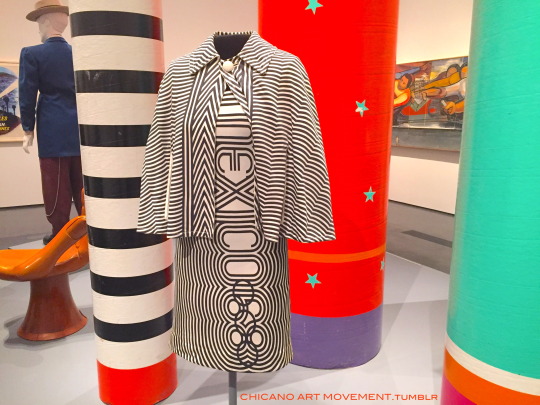
(View of dress and cape designed by Julia Johnson-Marshall for the 1968 Mexico Olympics.)
In mid-October 2017, we returned to Los Angeles County Museum of Art (LACMA) to enjoy the entirety of “Found in Translation: Design in California and Mexico 1915 - 1985,” another exhibition in the PST: LA/LA 2017 programming. We proceeded to main destination, the Resnick Pavilion, with tickets in hand. From the introduction, it communicated to patrons that Found in Translation was comprised of four sectors: Spanish Colonial Inspiration, Pre-Hispanic Revivals, Folk Art & Craft Traditions, and Modernism. In the accompanying catalogue, Wendy Kaplan (LACMA’s Department Head and Curator) explained in the introduction that this grand effort was the first its kind to analyze the exchange of ideas between California and Mexico & their respective manifestations in design and architecture between the years of 1915 to 1985. Kaplan further explained due to Mexico’s Revolution of 1910, it was crucial for Mexico to solidify their new identity and be on cusp of modernity in 20th century.
The first era of design that we ventured through was of Spanish Colonial Inspiration that contained various examples of how Spanish architecture dominated the landscape of Mexico and how it influenced the new image of the state of California. Post revolution, Mexico took a different approach to Spanish Colonial design that resulted in neocolonial style for art and architecture that combined Spanish colonial with indigenous iconography and elements.
For California, the translation of Spanish Colonial style was distinct in comparison. Spanish Colonial style was preferred due to its incorporation of Spanish and Mediterranean elements that were easily adaptable to the California landscape and, most importantly, it established a clear association to classic European civilizations and created distance from Mexico and its revolution of 1910. Spanish Colonial style in California was of having red-tile roofs, white stucco walls, and other Spanish & European elements; this was the standard until the 1930s. It dominated the blueprints of countless buildings: from personal homes to governmental structures such as: police stations, schools, and courthouses. One particular case study that I focused on was the city of Santa Barbara, California that after an earthquake decided to rebuild with Spanish Colonial design at the center; this resulted in many structures to be this style with the city’s courthouse being the most lavish example of Spanish Colonial style due to handcraft furniture done in Spanish Renaissance opulence, meticulous murals, and extravagant iron and woodwork.
We continued through the exhibition to the next period of design entitled Pre-Hispanic Revivals. As explained Pre-Hispanic Revivals flourished greatly due to the ease of international travel for both people and curated exhibits between 1910 - 1930 and continued as a source of inspiration in modern times. During this period, Mexico had two approaches: (1) applying Pre-Hispanic design elements from its various indigenous communities to modern items, and (2) organizing international exhibits of Mexico’s ancient indigenous artifacts to highlight the rich history of the Mesoamerican period.
For Californians, we learned it was an exportation and an unique interpretation of Pre-Hispanic designs. For some, it was the mixture of Aztec, Mayan, and other indigenous communities with home design. This was the approach that architect Frank Lloyd Wright used when creating the Hollyhock House and Ennis House, respectively. For other residents of California, the Pre-Hispanic revival was more personal particularly for Chicano and Chicana artists. Reading from the catalogue, we learned that after an inspirational trip to Mexico in 1970, David Botello applied indigenous elements of pyramids, temples, and other ancient structures to the Los Angeles landscape. Alongside Johnny D. González, they produced concept designs that reflected “Chicano urban planning” in East Los Angeles. One design was for the Tlalocán Commercial Center and another was for a Monumento de la Raza.
The third period of design we examined were of Folk Art & Craft Traditions. It was inclusive of ceramics, textiles, jewelry, and home items, wishing they were part of my collection. This section’s common denominator was of hecho en México (made in Mexico) and was a direct counter response to the industrialization movement of the 1940s & 1950s.
The catalogue stated the majority of artistic endeavors of this time was of exporting goods made in Mexico to the California market which was the case of Mexican silver from Taxco, Guerrero. During the 1950s, this small pueblo exploded to have 150 silver shops with the shop of U.S. born designer and businessman William Spratling at the forefront with international acclaim who sold items to Hollywood’s rich and famous, such as Marilyn Monroe and the blacklisted Dalton Trumbo. The Mexican American sculpture artist Dora De Larios (1933 - 2018) took a different approach in the area of folk art and craft traditions and within this exhibit, two of her works were included: Warrior (1960) and Blue Dog (1979). These pieces were mesmerizing examples of how the craft traditions from the indigenous communities of Nayarit and Colima were creatively interpreted by the artist. From our Pacific Standard Time (PST) research archives, we learned De Larios’ connection to this ancestral art form was due to a trip to el Museo Nacional de Antropología en la Cuidad de México with her family at the age of eight; it explained that the famous Aztec Sun Stone took Dora’s breath away and had a lasting impact on her.
The last section of “Found in Translation” was the phase of Modernism. After World War II, the rise of modern design impacted both sides of the U.S./Mexico border particularly in the sector of home design that invited clean lines, elements of nature, and bold, solid colors into the family’s daily visual topography. In California, the city of Palms Springs was a hub of mid-century modern homes and provided an oasis retreat in the middle of the desert. Throughout Southern California, mid-century homes were owned by working middle-class families who enjoyed a comfortable space that welcomed nature and simplicity in every way, shape, and form. In comparison, the modern homes of Mexico City’s neighborhood Jardines del Pedregal were of exclusive and attainable by the country’s elite class. We read from the exhibit publication that the Jardines del Pedregal homes were indeed inspired by California’s modern design architecture but with two distinct features: location was in an urban setting compared to the desert landscape and the homes were walled off from public view by request of the owners.
Modernism design was also applied to other areas particularly to the Olympic Games hosted by Mexico in 1968. El Comité Organizador de los Juegos del la XIX Olimpiada (COJO) included designers and architects that were entrusted with the large task of incorporating art in and around the area to welcome the thousands of people in town for this special occasion. The logo for the Olympic Games of Mexico 1968 was of great triumph. Created by U.S. born graphic designer Lance Wyman, he used the Olympic rings to recreate the numerical silhouettes of the six and eight in a repeated psychedelic zebra pattern. This design was also applied to the clothing worn by the countless female hostesses of the city as a method to provide uniformity and visibility within Mexico City during this time.
Overall “Found in Translation: Design in California and Mexico 1915 - 1985″ was an extensive exhibit that we perused one more time before leaving the Resnick Building. To close our trip to LACMA, we also toured PST: LA/LA’s “NuMu” (Nuevo Mueso de Arte Contemporáneo) by Guatemalan artists Jessica Kairé and Stefan Benchoam: a mobile museum contained in an egg-shape structure that in a previous life was a business stand that sold eggs.

(Lithography entitled “Mexico” by Maxine Albro from the “California Mexicana” exhibit.)
In late October 2017, Robert and I traveled to the coastal city of Laguna Beach, California to visit three PST: LA/LA exhibits. The first was “Descendants & Dissonance: Cultural Iconography in Contemporary L.A.” at the Salt Fine Art Gallery that exhibited artists Oscar Magallanes and Linda Vallejo. As I viewed the works by Oscar Magallanes of mixed media, I perceived the images as a reflection of the harsh realities of corporatism and its negative effects on people through familiar iconography. Linda Vallejo and her pieces were another installation of her series Datos Sagrados that incorporated Chicano/Latino recorded data into mandalas, geometric shapes and figures, that reflected the growing impact of the Chicano/Latino population within the United States. From PST: LA/LA literature, Sonia Romero was included in this exhibit. We inquired with gallery staff for the location of Romero’s work only to find out that, unfortunately, they were no longer on displayed due to the artist requesting their return before the closing date of the exhibition.
After the gallery, we walked to the second destination of the Laguna Art Museum on the corner of Pacific Coast Highway and Cliff Drive to see “California Mexicana: Missions to Murals, 1820 to 1930.” From the catalogue’s introduction written by Katherine Manthorne (guest curator of the exhibit), this collection of works was to display in chronological order the change of California from its Mexican inception to its incorporation to the United States in 1850 and its early decades as a young state located on the Pacific Ocean. From my point of view, I took this exhibit to learn more about the state’s history as well as the see other examples of the complex relationship between the distinct populations of our state: indigenous peoples, Mexicanos, Mexican Americans, and European immigrants. I also focused on the ranchero and vaquero lifestyles depicted by artists James Walker, William Han, and Henri Joseph Penelon, respectively. In addition, I concentrated on the works by William Joseph McCloskey, Norman Rockwell, and Maxine Albro that displayed the abundance of agricultural fertility in California that allowed the state to grow and create a strong economy during the early part of the 20th century.
After surveying the last room of “California Mexicana,” Robert and I walked down to the lower level of the Laguna Art Museum to see “Dan McCleary: Prints from Oaxaca.” The American artist McCleary displayed the different stages of the printmaking processes that he learned from various artists while working in Oaxaca. This included the original copper plate etchings and in their different stage variations as well as original works on canvas and prints on paper.
Stay tuned here and our other social media sites for the second installation of a three part series by CHICANO ART MOVEMENT blog’s coverage of the review of PST: LA/LA Attended Programming.
#latino art#latin american art#contemporary art#latinx art#mexican art#argentina#xicana#perfomance art#mexican american#chicano art#pst#chicana#american art
50 notes
·
View notes
Text
"Wars, Sherona Shapen once famously states, are started by stupid people with dumb opinions they want the world to share."
In addition to being the blurb on the back cover of her best-selling memoir Ten Years In Hell: Shaping The Future Of America On $15,000 A Year, her opening statement as a grand jury witness in the 2017 Swell View Board of Education vs. Barry and Linda Birnbaum chocolate milk scandal case, and at the end of a mohito and chicken slider-filled don'tletmediealone.com date-the beginning of a deeply unfortunate tatoo (five minutes in she remembers how sharp needles are, briefly regrets all of her life choices and rolls out of her chair yelling "not today!" with half of a W on the back of her neck.) it's the thesis of the Global Conflict unit she designs for the tiny, life-sucking mouth breathers in her fourth period History class three weeks before Thanksgiving break. Although much has been written about the controversial nature of the unit (the ensuing protests that divide a once happy, stable community, the thorough investigation into the subject matter and what role-if any-it plays in the series of harrowing events Swell View citizens collectively refer to as "Chrismapoloypse") and the depth of the chaos is covered extensively both in Carmen Aula's 2016 school board political thriller Save The Children and Sherona Shapen's seven hour Larry King interview that only ends when Larry quits on air and checks himself into a hospital, the abridged version of events is available on Swell View's Infopedia page incorrectly filed under "natural disasters".
It looks like this:
· September 30th, 2015- Principal Wiggins denies Miss Shapen's request to teach the Global Conflict unit, calling the lesson a "downer" and insisting the children's tiny, little brains are too "soft" and "gooey" this time of year for the bad vibes and harsh realities of "countries straight up killin' other countries".
· November 1rst (11:00am)- Miss Shapen barges into the officee screaming about tyranny and censorship; Principal Wiggins hides under his desk playing Zombie Barista IV on his pear pad until she's hauled away by security.
· November 1rst (2:15)- A large dent appears in the drive's side door of Principal Wiggin's brand new Mercedes S Class. (Witnesses report the sighting of a puke green hatchback fleeing the scene. This is later confirmed by crime scene anyalsis of the outgoing tire tracks.)
· November 1rst-5th- Miss Shapen sends Principal Wiggins approximately one hundred and seventy five texts\facesplash messages\pear chat requests.
· November 6th (10:30 pm)- Principal Wiggins hears rustling sounds in the bushes under his bedroom window; briefly considers buying a taser from the Defend Ur Self superstore.
· November 10th- Miss Shapen stands in the corridor asking students why their principal is a lying, two-faced coward who won't answer her snap chats.
· November 12th- Miss Shapen requests a truce. Is in the principal's office for five whole seconds before she's knocking everything off the receptionist's desk, throwing pieces of Principal Wiggin's "bonzai forest" across the room, and running away from campus security singing We Shall Overcome in an unbearably screechy falsetto.
· November 14th- Miss Shapen listens patiently while the best-reviewed lawyer on Bellow tells her she doesn't have much of a case; throws her pear phone out of her kitchen window.
· November 15th (9:00am)- Sherona Shapen thinks eff it, begins lesson one\thirty-six of her Global Conflict Unit.
"In my defense, the bespectacled former educator tells Larry King, Arthur Wiggin was a #@!? moron."
A spectacular idiot. A corn knob whose raw, home-style dumbness was so rarified she was sure humanity was only capapable of producing someone this stupid once a millenium. Attempting to have a conversation with a middle aged man who sings along to his Wrecking Ball ringtone would be hard enough, but it's November, which means his office looks like the spirit of Christmas became an actual thing and puked all over it, and that he's already dressed in his official mall Santa costume. (In keeping with Swell View Jr. High tradition, "Santa Wiggins" will wander the halls drawing expulsion notices, "sudden death" academic probation slips, and fifteen dollar Boston Market gift cards out of his great brown bag.) She keeps her distance 'cause she's fairly certain his costume was last dry cleaned circa 2003, and uses small words so his tiny, little, baby brain won't get scared\confused but nope, turns out writing thirty-six lesson plans for a bunch of googley-eyed, yolo-obsessed, jerk tweens is actually more bearable than even a moment of hearing Principal Wiggin try to talk while adjusting his fake beard.
So, Sherona goes home and writes. A lot. So much she forgets to heat up her Singles Serving TM guacamole and spinach meal, post her latest update of her brave, selfless struggle on BitterTeacherBlog.com, and feed her cats, a fact which doesn't change even when they circle her desk meowing threateningly. She falls asleep on her keyboard sometime after midnight.
"Listen up hooligans, She growls after all the groaning from the announcement of the new unit subsides, In honor of the season we're going to have a little competition."
She rolls her eyes and prays for retirement when the class breaks into fresh groans.
"Shut your traps, I've got five weeks of staring at your little groundhog faces till we're both free and it's going to go by a lot slower the dumber you act."
In the middle left row Henry Hart opens his lopsided mouth (probably to tell her he does not have a groundhog face) but she glares at him so hard he tries to back away while seated.
"Now, she clasps her hands behind her back, paces the length of the room like a decorated general addressing her least ambitious troops. Because we live in a Yule-obsessed black hole most of you will spend the next three weeks chugging egg nog and harassing Santa on twitter.
2 notes
·
View notes
Link
Rising for a Global Feminist Future with the Movement to Elect Bernie Sanders.
We are a coalition of feminists contending with both our differences and our commonality in age, race, class, religion, labor, and sexual orientation. We meet at the intersection of our fluid identities. Though our experiences are different, we share a vision of a feminist future.
We urgently call in our friends, families, and comrades to unite with us in the broad passionate movement supporting Senator Bernie Sanders’ campaign, and to work to heal the relationships necessary to create a new era for our communities, this country, and the world. We support the volunteers, door knockers, and movement to elect Senator Sanders because his proposed policies are ideas whose time has come. All of our lives we have been creating movements and art organized around the critical basic human dignity of all people. We support the movement to elect Senator Sanders because engaging electoral politics is a part of the larger strategic democratic movement for solidarity and a feminist future to take hold. We believe an end to patriarchy demands an end to class and racial oppression.
All across this country and globe, women and children have been working toward a shift in collective consciousness. A feminist future requires political change by men, women, and gender non-binary people not just in the structures and laws but in our collective values and behaviors. It requires an end to violence against women, girls, and all femme people. A feminist future demands the spirit of cooperation. We are inspired and motivated by the grassroots movements brewing across the globe and here in the United States of America for decency, dignity, and respect. We amplify poor, unemployed, and working people behind this political moment aching with passion and anxiety toward the uncertainty of tomorrow. We must strategically rally and rise together.
Time is not on our side.
We are explicitly naming the ecological disaster we are facing and we must vote for a future where our environment and our planet are treated with the utmost respect and protection. A world where our rainforests are protected, where clean drinking water is not a privatized commodity, and the earth is finally free of fracking and extraction. We are voting for a future to end poverty and rebuild the corrupt dehumanizing state of our world and the fragmentation of ourselves. We choose a politics of collectivity. We choose a future that honors social responsibility and connection.
We stand with the abolitionists, healers, and storytellers who pursue a world where we are brave enough to consider one another and fight for each other. We envision a world where discrimination, war, and white terrorism are laughed out of the room and become a thing of our past. Where we honor the dignity, respect, and self-determination of the Palestinian people. Where the people of Puerto Rico are free of colonial debt and domination. Where our government commits to the transformational power of an authentic apology and restorative process with millions of people displaced and torn apart by corporate interests masked as foreign policy.
We envision a formal acknowledgment and apology to the First Nations of this land and accountability for the millions of African-Americans oppressed by this country’s denial of the generational repercussions of slavery and Jim Crow. We envision a world that boldly confronts its past so that we can begin the corrective process of atonement, repair, and healing.
We vote for a future free of state inflicted, sponsored, and sanctioned violence. In the not so far and brilliant feminist future, we look forward to communities free of dominance, aggression, isolation, and separation. Where no child is caged. Where schools and communities are free from police and prisons. We envision a world without violence.
We envision a country and world that prioritizes mental health and therapy as universally accessible. We look forward to a future where comprehensive high-quality childcare and education are free. We believe in a future where nobody gets evicted or has to choose between medicine or food. Where we each have the access and ability to vote and be counted.
We look forward to the day of true sexual autonomy and personal reproductive freedom. Where access to safe abortions, contraception, and quality health care is a human right. Where all forms of violence against all women, cis-gender, transgender and non-binary are a distant memory.
We write this statement alongside the broken-hearted people of this country and we welcome the courageous risk a feminist future requires. Our “we” is bigger than any one campaign, person, or agenda. We know that Senator Elizabeth Warren has inspired so many women who care about justice and freedom. Because of their values, and because they are women and non-binary supporters, they have faced skepticism and misogyny. Many of us, including Senator Sanders, have condemned these attacks and continue to do so. We invite Warren supporters to continue to fight for a future that she believes in with us- Medicare for All, a bold Green New Deal, student debt cancellation, and a world where people are not attacked on the basis of their gender, sexuality, race, class, immigrant status, disability, or criminal legal status.
We also know that people may consider Joe Biden because he seems safe or a return to normal but through Biden many people who are sick will continue to die because he opposes universal healthcare. The planet will perish because his climate plans are weak. Immigrants looking to rebuild a home will be deported and Black people will continue to be murdered by police. We deserve more. We are all we got. Senator Sanders cannot guarantee a feminist future, it is up to us. But between him and Biden, Sanders is the clear choice. Biden represents the worldview that brought us enormous income inequality and injustice.
For the nurses, teachers, cooks, domestic workers, bus drivers, farmers, librarians, organizers, caretakers, writers, sex workers, shamans, and waitresses: there’s another America waiting for us and we are ready to greet her. We need you to participate, to cooperate, to be a part of shaping our future on this planet together. Join us.
Read this statement aloud with your friends. Share it in your communities. Post it on your platforms. Let’s organize for a #FeministFuture #IWD2020 #Bernie2020.
In struggle and with love,
Melina Abdullah, Thandiwe Abdullah, Zaina Alsous, Taina Asili, May Boeve, Cori Bush, Rosa Clemente, Patrisse Cullors, Molly Crabapple, Jonel Edwards, Jodie Evans, Eve Ensler, Zillah Eisenstien, Barbara Ehrenreich, Laura Flanders, Rachel Gilmer, Kim Gordan, Sandra Guzman, Alexandra Halaby, Leah Hunt-Hendrix, Mahdis Keshavarz, Naomi Klein, DJ Kuttin Kandi, Rachel Kushner, Winona LaDuke, Sarah Leonard, Annie Leonard, Aya De Leon, Thenjiwe McHarris, Jane McAlevey, Anuradha Mittal, Aja Monet, Helen Peña, Carmen Perez, Derecka Purnell, Varshini Prakash, Barbara Ransby, Shana L. Redmond, Linda Sarsour, Barbara Smith, Beverly Smith, Sarah Schulman, Sandra Steingraber, Susan Stryker, Keeanga-Yamahtta Taylor, Astra Taylor, Sunaura Taylor, Opal Tometi, Amy Vilela, Kenidra Woods
If you’d like to add your name please sign on here: https://docs.google.com/forms/d/e/1FAIpQLScS8tZ1JG_n5Oo3p01n0ixWyqNGg8cVIhXUNSEO6KFVhCOU5A/viewform?usp=sf_link
0 notes
Text
Faith Ringgold's Art Featured Around the Country and Abroad #JACBA Newsletter 21Jul2017
Professor Emerita Faith Ringgold Featured in 'Soul of a Nation'

Featuring more than 150 works by over 60 artists, many on display in the UK for the first time, Soul of a Nation will be a timely opportunity to see how American cultural identity was re-shaped at a time of social unrest and political struggle.
Soul of a Nation will showcase this debate between figuration and abstraction, from Faith Ringgold's American People Series #20: Die 1967 and Wadsworth Jarrell's Black Prince 1971 to Frank Bowling's Texas Louise 1971 and Sam Gilliam's April 4 1969. A highlight will be Homage to Malcolm 1970 by Jack Whitten, who was awarded the National Medal of Arts by Barack Obama in 2015, which will be going on public display for the very first time.
Read More
Aunt Harriet's Underground Railroad in the Sky by Faith Ringgold 1993 Awardee
'It Remains Relevant - History Repeats Itself' Faith Ringgold discusses the importance of art
AT THE time I made American People Series #20: Die, all hell was breaking loose across parts of the United States.
There were riots as people fought for their civil rights.
Not much of this was being recorded in the press or on the TV news, but I saw the violence myself, and felt I had to say something about it.
Read More
Soul of a Nation: Art in the Age of Black Power, review

Benny Andrews's Did the Bear Sit Under a Tree? is one of a number of punchy message-driven works that set the scene: the Stars and Stripes rolled back to reveal an angry black man waving his fists both at the Flag and the viewer. If the execution is none too subtle, with the figure rendered in rough-hewn sacking-relief with a zip for a mouth, Andrews wanted to reflect the "raw" aesthetics of his background in rural Georgia.
Faith Ringgold's Die creates a frantic pattern of wild-eyed, bleeding black and white people in which it's impossible to tell who's stabbing or shooting who, all in a compelling pop-expressionist style that isn't revisited in the exhibition or, it seems, the artist's own work.
Read More
Aunt Harriet's Underground Railroad in the Sky by Faith Ringgold 1993 Awardee
Soul of a Nation - Art in the Age of Black Power, exhibition review: Pride and prejudice. This ambitious and energetic show charts 20 years of the struggles that formed the modern black artistic identity in America
Tate Modern's Soul of a Nation: Art in the Age of Black Power is a trip through 20 years of black artists in the US experimenting with what black art could possibly be.
Benny Andrews worked with Bearden in another group, the Black Emergency Cultural Coalition. In Did the Bear Sit Under a Tree? (1969), a black protester shakes his fist at the American flag, which is meant to protect him, but is seen closed-off in its own cold space.
Read More
Delivering Justice: W. W. Law and the Fight for Civil Rights, written by Jim Haskins, illustrated by Benny Andrews 2006 Awardee
Spencer Museum exhibitions highlight African-American story quilts
The Spencer Museum of Art recently opened two evocative exhibitions that highlight African-American quilting traditions.
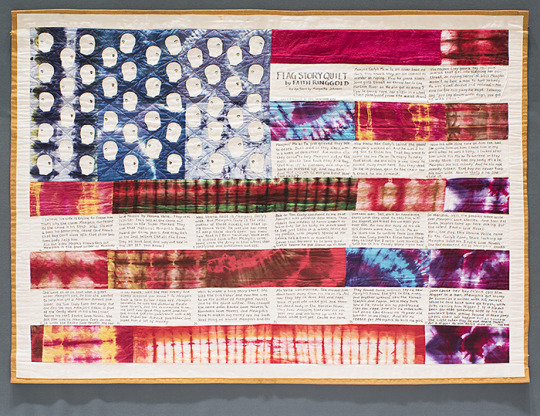
To complement this exhibition, Earle curated "Narratives of the Soul," which presents significant African-American quilts from the Spencer Museum's collection, as well as regional and national loans. One highlight of the exhibition is the art museum's "Flag Story Quilt" by renowned artist Faith Ringgold. Ringgold will give the keynote lecture for the Quilt Convention on Wednesday, July 12, at the Lied Center.
Read More
Find out how to choose the right book during at A.K. Smiley Public Library presentation
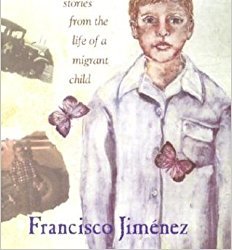
On Sept. 7 an upcoming adult literacy event when author Francisco Jimenez will speak at the Contemporary Club at 6 p.m. Jimenez, is the author of "The Circuit" and "Breaking Through," autobiographical stories about his life as a child of migrant workers and his love of education.
Read More
The Circuit: Stories from the Life of a Migrant Child by Francisco Jiménez 1998 Awardee
Poetry Sunday: Lauren Wolk Local NPR for the Cape, Coast & Islands
Lauren Wolk reads her poem "Shopping for Bras."
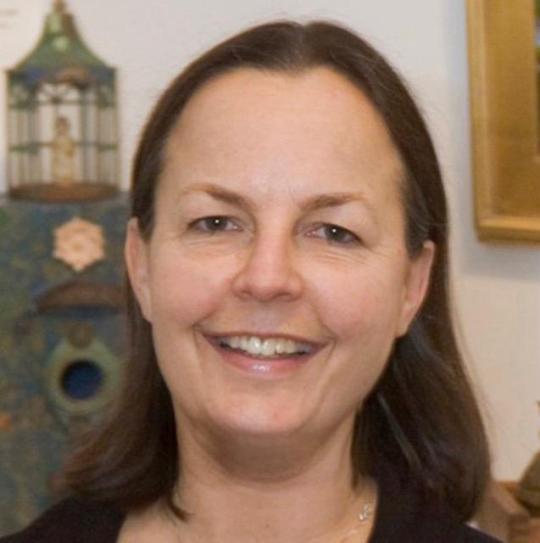
Read More
Wolf Hollow by Lauren Wolk 2017 Awardee
The Vibrant Art Of Roxbury's Ekua Holmes Recalls The Harlem Renaissance

The exhibit mostly displays Holmes' paintings for the children's books she has recently illustrated, including her works on Fannie Lou Hamer, titled "Voice of Freedom" and "Out of Wonder, Poems Celebrating Poets." The Hamer book, produced with writer Carole Boston Weatherford, garnered a children's book trifecta: The Caldecott Honor Book, The Robert F. Sibert Honor Book and the John Steptoe New Talent Coretta Scott King Award.
Read More
Birmingham, 1963 by Carole Boston Weatherford 2008 Awardee
Carlsbad Museum opens children's books illustration exhibit
The exhibit, "Childhood Classics: 100 Years of Original Illustration from the Art Kandy Collection," is open through Sept. 30 to allow for class field trips to view illustrations from children's books.
The exhibit, which originally opened in California, features original illustrations from Dr. Seuss' "Cat in the Hat", Garth Williams' "Stuart Little," "Where the Wild Things Are" by Maurice Sendak and Floyd Cooper's "Jump! From the Life of Michael Jordan."
Read More
Ruth and the Green Book by Calvin Alexander Ramsey with Gwen Strauss and illustrated by Floyd Cooper 2011 Awardee
THE PEN TEN WITH CARMEN AGRA DEEDY

In this week's interview, we speak with Carmen Agra Deedy, author of The Rooster Who Would Not Be Quiet!, a children's book-illustrated by Eugene Yelchin-about a rooster who insists on singing despite the mayor's no-singing laws. Deedy discusses young readers, surveillance, and the use of humor when confronting difficult realities.
What is the responsibility of the writer of children's books?
To respect the intelligence of young readers and never, ever, lie to them. They will love you for the former and crucify you should you ignore the latter.
Read More
The Yellow Star: The Legend of King Christian X of Denmark by Carmen Agra Deedy 2001 Awardee
Meigs ancestor became renowned author
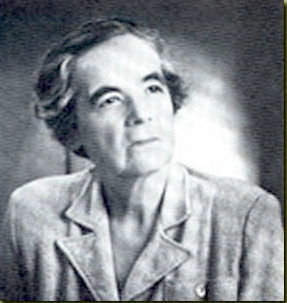
The fame of the Rodgers family of Perryville and Havre de Grace extends far and wide with Commodore John Rodgers being the top echelon of that pyramid of fame.
If one were to trace the lineage of Meigs and Rodgers families for a bit, one will arrive at another Meigs of note who, sadly, hasn't reached the level of fame and recognition as her male ancestors with their impressive military careers. This ancestor was Cornelia Meigs, an author of fiction and biography, a teacher and historian of note and a critic of children's literature. Truly she was an astounding woman who contributed greatly to children's literature as a whole.
She would leave Bryn Mawr to teach writing at the New School of Social Research in New York and was the lead editor and a writer of "A Critical History of Children's Literature," published in 1953. The book was called landmark in the field of children's literature studies. It was later revised under Meigs' critical eye and reissued in 1969.
She would write over 30 fiction books for children, two plays, two biographies and several books and articles for adults.
Read More
Jane Addams: Pioneer of Social Justice written by Cornelia Meigs 1971 Awardee
Books raise awareness, sensitivity to suffering
Today's reviewed books help create a more sensitive awareness of this global problem that promotes empathy, and that's a very good thing because if we were among the 65.6 million displaced people in the world, we'd surely want others to be empathetic toward our plight and offer us help.
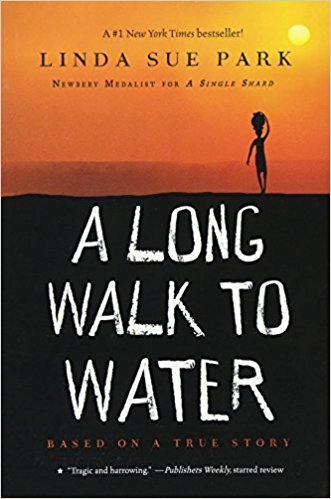
"A Long Walk to Water" by Linda Sue Park
Alternating narratives of two young people living in Sudan, this book is based on the true story of the life of Salva Dut, who, at age 11, was separated from his family and village during yet again another battle in the Second Sudanese Civil War. Against all odds, Salva's journey of many years, walking from one refugee camp to another, across Africa to Ethopia, to Kenya and back to Sudan, demonstrates enormous courage, hope and the will to survive.
The second voice in "A Long Walk to Water" is young Nya, who walks for eight hours every day simply to fetch water. How and why their lives intersect is both profound and moving.
An important work in many regards, "A Long Walk to Water" not only raises an awareness of the suffering of others, but in so doing, helps readers develop compassion, empathy and a deeper appreciation of those things many of us take for granted.
Read More
A Long Walk to Water: Based on a True Story by Linda Sue Park 2011 Awardee
When My Name Was Keoko by Linda Sue Park 2003 Awardee
Thoreau Bicentennial Gathering: Celebrating the Life, Works, and Legacy of Henry David Thoreau

PEN New England presentation of Thoreau Prize for Nature Writing to Sy Montgomery (Sy Montgomery, a naturalist, author and scriptwriter who writes for children as well as adults)
Read More
Temple Grandin: How the Girl Who Loved Cows Embraced Autism and Changed the World by Sy Montgomery 2013 Awardee
Western Washington University and the Whatcom County Library System chosen as site for 2018 Arbuthnot Lecture
The 2018 May Hill Arbuthnot Honor Lecture featuring Naomi Shihab Nye will be held in the spring of 2018.
Sylvia Tag, Curator of The Children's Literature Interdisciplinary Collection, noted that, "Naomi Shihab Nye spreads hope and light through her poetry and prose. Western Washington University and the Whatcom County Library System are honored to host the Arbuthnot Honor Lecture, and invite her particular brilliance to illuminate our diverse and word-hungry communities."
Read More
Habibi by Naomi Shihab Nye 1998 Awardee
Sitti's Secrets by Naomi Shihab Nye, illustrated by Nancy Carpenter 1995 Awardee
---
Since 1953, the Jane Addams Children's Book Award annually acknowledges books published in the U.S. during the previous year. Books commended by the Award address themes of topics that engage children in thinking about peace, justice, world community and/or equality of the sexes and all races. The books also must meet conventional standards of literacy and artistic excellence.
A national committee chooses winners and honor books for younger and older children.
Read more about the 2017 Awards.
2 notes
·
View notes
Text
Intersectional Feminism In the Classroom
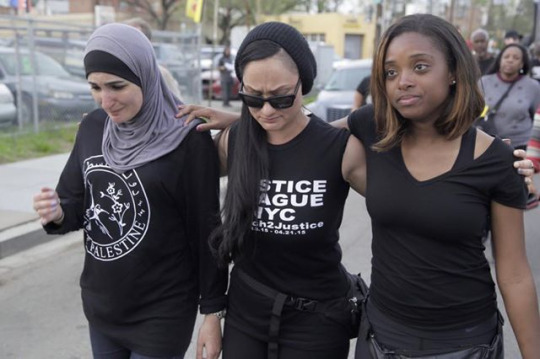
(Photo Source: These Are The Fierce Activists Leading The Women’s March On Washington)
On both January 21st and 22nd of this year, three women organized the country’s largest political demonstration, drawing in nearly half a million Americans to The Women's March on Washington and over 3 million nationally. These women - Linda Sarsour, Tamika Mallory and Carmen Perez – sought to amplify the voices of all those who find themselves at the mercy of patriarchy’s clenched fists. In addition to the typically advertised causes of feminism including reproductive rights and the gender wage gap, protesters rose signs calling attention to police brutality against black bodies, waved rainbow flags in support of LGBT identifying folks, and called out against the Dakota Access Pipeline. This was a demonstration of third wave feminism. This was intersectional. And despite the valid intra-community criticisms against the actual execution of the Women’s March, I ask what we as educators can take away from this major event and how can we bring what we learned into the classroom?
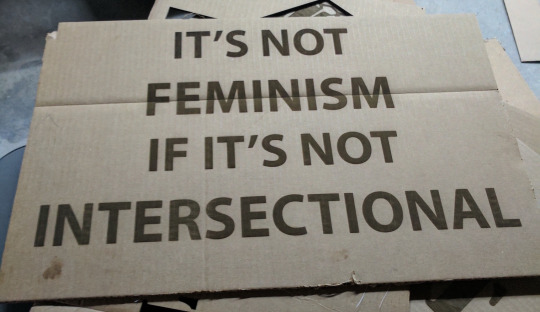
(Photo Source: Do I Have a Place in Your Movement? On Intersectionality at the Women’s March on Washington)
Intersectionality, coined by scholar Kimberlé Crenshaw, is “ a concept to describe the ways in which oppressive institutions are interconnected and cannot be examined separately from one another”. All of us hold a multitude of identities that are consistently interacting with one another and with the institutions we come into contact with. I, for example, am a white-passing, Puerto Rican, cis gendered, bisexual, able bodied, middle class raised woman. All these identities have directly and indirectly contributed to the opportunities I have had, the worldview I hold of society and my place in it. Change any one of them, and those very opportunities and perspectives change. Even amongst those who share similar identities, we find diversity. And if we know anything about this country’s history, some identities are privileged over others for no reason other than institutionalized ignorance refusing to retire unearned power. As educators, we participate in what has historically been intended to further the oppression of marginalized people, pacifying youth with white washed, patriarchal narratives that erase the injustices forced against them and the generations before them. And as agents of this system, we are especially obligated to reflect on the power bestowed on us over the development of young minds.
When approached to write this piece, I was prompted with the question: Why is it important for educators to understand what intersectional feminism is? The answer, for me, is simple: because we are responsible for the holistic development of youth that ought to not only be prepared to survive oppressive systems or excel in them, but to dismantle them. White feminism, also known as first wave feminism – a debatable term considering the ideology surrounding equality and equity amongst the sexes is one found well throughout history, not limited to white American women – has never represented the voices of women and non men whose gender identity is compounded by other systems of oppression (i.e., class, race, ability, sexual orientation). It is, therefore, incomplete and inapplicable to classrooms that seek to create a generation of liberated thinkers.
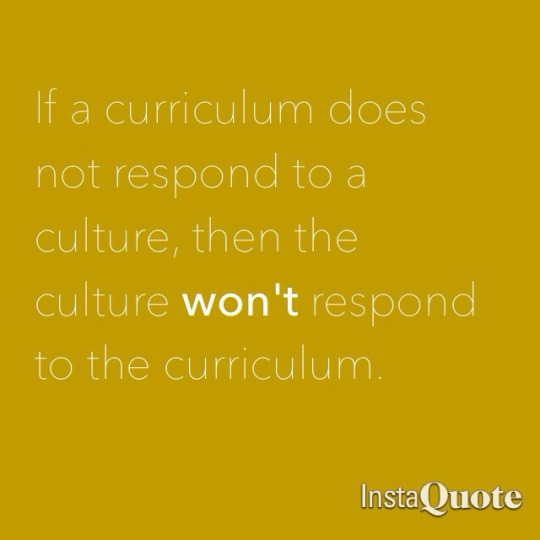
So, what is the first step? We look at the syllabus. Often times when discussing feminism, the target audience is young girls and women (again, by default, typically white). But intersectional feminist thought centers the experiences of all non men, especially marginalized demographics such as women of color and trans women. It must be clear that middle class, cis het, able-bodied white men (and women) cannot be the only people that exist in our curriculums. They are not the only authors who have stories to be told. They are not the only inventors with contributions to be celebrated. They are not the only leaders to write essays about. They are not the only survivors of tyranny with pain that cannot afford to be ignored. Only when we actively and intentionally engage our students in material that reflects these realities, which may or may not reflect that of the students, are we using our position as educators to develop and liberate young minds.
What we teach, however, is not the only line of defense against a white supremacist, patriarchal, academic agenda. How we teach is what separates intention from impact, especially when educating vulnerable populations (i.e., non men of color). Intersectionality is primarily concerned with making visible and audible the narratives of non men typically and systemically ignored. For the past three years, I have served as the program director of the L.A.C.E. Youth Leadership Program, educating low income, inner city Puerto Rican youth grades 6-12. I learned rather quickly that my students are far more knowledgeable about their realities than any college textbook could prepare me for. I learned that my voice was not the most important in the room, that they are aware of what matters to them – and if intersectional feminism teaches us anything, it is that people are the experts on their own lives and it is their voices that ought to speak for their experiences.
But if we are honest, this is not an approach that most students are accustomed to. Educators hold a privileged position over students in that we are the decided expert in the classroom. This can be especially dangerous when educating non men of color, for example, whose voices are often interrupted, undervalued and invalidated. If we are intent on cultivating multiple perspectives, especially within the context of intersectionality, it is vital that educators make an exerted effort to create safe spaces for these students while also allowing for more privileged students (whether that be due to their race or gender) to actively listen to their fellow classmate. Whether that includes house agreements created by the students in the efforts of structuring fair and impactful discussions, or creating seating arrangements that de-emphasize a primary speaker, or encouraging students to make “I” statements so to not speak in generalizations and encourage interpersonal dialogue that builds connections, there are several ways to ensure that all voices are heard and, most importantly, that no marginalized voices are spoken over.
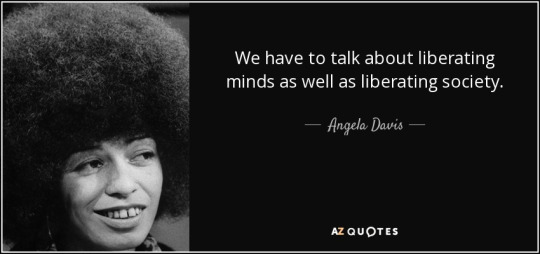
One of the best teaching methods I have found to promote an intersectional agenda – and therefore an agenda rooted in self liberation, equity and community – is to pose students as the teachers. If the goal is to cultivate multiple perspectives within the feminist group, the educators cannot always be the main one talking. I refuse to facilitate every group discussion, especially when the topic is of something that does not directly impact me. In discussions about racism, for example, I - a white passing Boricua woman – would do better to co-facilitate alongside my Afro Boricua female student who is directly impacted by the topic at hand. In addition to cultivating leadership and public speaking skills, both she and her classmates are able to see a young black woman, who not only experiences racism, but sexualized racism at that, at the center of a discussion that has material consequences in her life. In this space, if only in this space, she has the power to structure a conversation about misogynoir amongst a mixed group on her own terms. That is the kind of leadership I want my students to have. That is the kind of feminism I want my students to practice.
I do not see intersectional feminism as some theoretical ideology reserved for dissertations and stimulating conversation amongst the academic elite. It is a tool. One that seeks to personalize the human condition and, if executed properly in the classroom, allows everyone an opportunity to transform what is often a mechanical, academic environment into a space that centers community building amongst youth on the collective desire for self-determination.
MRM Guest Blogger: Roslyn Cecilia Sotero
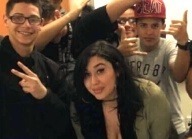
Roslyn Cecilia Sotero is a graduate of the University of Connecticut with a Bachelor of Arts degree in Human Development and Family Studies. During her undergraduate career, she served as Vice President and President of the Latin American Student Organization (LASO), which provided an array of cultural events and services to students of the Waterbury regional campus.
LASO opened up professional opportunities for Ms. Sotero when she connected with the Hispanic Coalition of Greater Waterbury, Inc. who at the time was looking to create a new youth program. Excited to be working within the local Latinx community, Roslyn drafted a program curriculum that was used as part of a $60,000 state grant application. For the past three years as Program Director of the LACE Youth Leadership Program, Roslyn has catered to the academic, professional, personal and cultural development of youth of color throughout Waterbury's public school system. And as is the vision of the Hispanic Coalition for local youth, Roslyn led the creation of three local art exhibits in CT's first Latinx Art Center, El Centro Cultural, where LACE students took the lead in educating the public about Latinx histories.
In addition to her director position, Roslyn continues to educate Brown and Black communities on social justice issues by serving on several panel discussions across CT, MA and NY specifically in regards to issues close to WOC, education equity, youth-led activism and anti-blackness within Latinx communities.
7 notes
·
View notes
Text
Nevertheless, She Persisted: A Year After The First Women’s March, Energy Is Still High
NEW YORK ― Marsha Annon and Yong Lee didn’t attend the 2017 Women’s March on Washington. Annon, 44, had never been to a protest in her life before Saturday. But she and Lee, 42, decided to take their 7-year-old daughter to the 2018 Women’s March in New York City, joining more than 200,000 marchers locally and hundreds of thousands more around the world.
“It’s time for change,” said Annon, who told HuffPost that it was #MeToo, specifically the Aziz Ansari story, that pushed her to march. “We need to stop making excuses, and I don’t want my daughter to grow up in a world where she feels pressured to do things that she’s uncomfortable doing.”
The day after President Donald Trump was sworn in last year, women and men across the country took to the streets, making the first Women’s March the largest single-day protest in U.S. history. A year later, on the day of a government shutdown, the energy and rage are still there, bolstered by the #MeToo movement and anger at an administration that has been actively hostile to the rights of women and other marginalized groups.
In New York, the march spanned more than 20 blocks and two avenues. Marchers of all ages, genders and backgrounds carried signs with slogans like “Grab him by the midterms,” “Harasshole,” “I miss science,” “Stop tearing families apart,” “Nasty women from shithole countries,” “Together we rise,” and “Fuck this shit.”

Alanna Vagianos/HuffPost
Marsha Annon, Yong Lee and their 7-year-old daughter at the NYC Women's March on Saturday.
Despite a year that several women described to HuffPost as “hard” and “draining,” marchers seemed prepared to call their representatives and protest in the streets for the next three years.
“After marching many times, I would march next year and the year after that, and I would continue marching,” said Tessa Cahill, 11, who marched in D.C. with her family in 2017.
Though the themes of the 2018 march remained largely the same as last year’s, many women pointed to the #MeToo movement, which kicked off in earnest this past October, when asked why they were marching again.
“I feel optimistic, especially with so many women coming out in the #MeToo movement [and] in Time’s Up,” Danielle Sabalvaro, 26, told HuffPost. “Enough is enough at this point ― especially after this past year. So I think we have a lot of momentum coming into this year.”
Nikki Vargas, 30, said she had protested and marched before Trump was elected, but was especially energized this past year by #MeToo and her identity as a Colombian immigrant.
“This march is even different from the last one because of the #MeToo movement and the spotlight on sexual assault victims,” Vargas told HuffPost. “There’s a lot more rage and a lot more anger in this march, and I think we’re going to see a lot of women out there defending those who didn’t have a voice before.”
Another clear difference between this march and the one in 2017 was an effort to work for inclusiveness and intersectionality from day one. The original march, which grew out of two Facebook events created by white women, drew criticism for not initially doing so.
The founders of the Women’s March changed the name of the event from the “Million Women’s March” ― the name of a 1997 black women’s march ― brought seasoned organizers Linda Sarsour, Tamika Mallory and Carmen Perez on as national co-chairs, and say they have since spent a lot of time discussing and reflecting on white privilege and the problems with white feminism.
“I think it was important for all of us to talk about the ubiquity of white privilege and how we all had been basically skating on this privilege without really naming it or addressing it for a very long time,” said Bob Bland, a co-founder of the march. “We learned about the history and the ways we were causing harm and trauma to communities of color, and we centered women of color in leadership and became intentional as white women about holding space.”

Alanna Vagianos/HuffPost
Veronica Pazmino, 28, wore red at the NYC Women's March to honor indigenous women.
Many women brought signs to the march that emphasized inclusivity. Veronica Pazmino, 28, in New York with an indigenous women’s group from Mexico, said she wore red to honor indigenous women.
“I just really wanted to show solidarity and stand with all my sisters here today, all native sisters, all trans sisters,” she told HuffPost. “And I really feel like it’s important to stand together, be inclusive, not exclusive. This is about all groups of women, not just certain groups of women. Be intersectional and not be like, oh, this is only for certain groups and not the others.”
Majella Mark, 31, carried a sign that nodded to “pro-life feminists,” despite the fact that she supports abortion rights and that feminism has traditionally shunned the anti-abortion community. “There’s women who really are dedicated to gender equality, and their perspective is just different, and that’s OK,” she said.
The march still drew some criticism this year, and some women of color chose not to attend, citing lack of intersectionality and other reasons.
But Bland said she is encouraged by the movement’s evolution.
“The miracle of this year is people putting away any past differences ― or more accurately, talking about them ― and having the courageous conversations that needed to be had with each other,” she said.
I would say our greatest victories are ahead of us. The true promise of the Women’s March hasn’t yet been met. Bob Bland, Women's March Co-Founder and National Co-Chair
One year into Trump’s presidency, demonstrators see the Women’s March as a jumping off point rather than an end goal. And with the midterm elections just months away, that’s where many of the marchers plan to direct their energy. That’s also where the Women’s March organization has directed its efforts, via the Power to the Polls campaign, which kicks off on Sunday in Las Vegas.
“It’s a marathon fight, not a sprint,” said Marianna Martinelli, 35. “Now it’s 2018, we’ve got our eyes on November and trying to support candidates that are gonna be able to make a change in D.C. So I think we know that it’s gonna be the long haul. It’s not guns blazing ― we’ve gotta keep the pace, keep fighting.”
“It’s wonderful to see this kind of turnout,” echoed Sydney Crawford, 83, who has been marching since the 1960s when she fought for civil rights alongside Martin Luther King Jr. “I was with a group in Virginia, and we took 12 seats in the state legislature and got the governorship. People came out and voted, and it was really inspirational.”
Bland shares the optimism of the New York marchers.
“I would say our greatest victories are ahead of us,” she said. “The true promise of the Women’s March hasn’t yet been met.”
This piece has been updated to reflect a later crowd size estimate.
RELATED COVERAGE
Why This Black Girl Will Not Be Returning To The Women’s March
Women's March Draws Massive Crowds In Cities Across The Nation
Download
More From this publisher : HERE ; This post was curated using : TrendingTraffic
=> *********************************************** Post Source Here: Nevertheless, She Persisted: A Year After The First Women’s March, Energy Is Still High ************************************ =>
Nevertheless, She Persisted: A Year After The First Women’s March, Energy Is Still High was originally posted by 11 VA Viral News
0 notes
Text
Starting a Revolution

Hundreds, thousands, millions. All marching with the harmonious objective of advocating not only women’s rights, but those of other marginalized groups such as minorities, LGBTQ, etc. Starting a march or activist movement is no easy feat. For Teresa Shook, however, it seemed as easy and instantaneous as creating a Facebook page. It was November 8th, the world had all eyes on the United States as Donald Trump had just won the presidency.
Like many others, Teresa was dumbfounded, discouraged, and upset at the election outcome. The next night, she took to Facebook and created a Facebook event page calling for a march on Washington after Trump’s inauguration. The retired attorney went to bed with 40 responses and woke up to more than 10,000. Bob Bland, a New York-based fashion designer did the same and pushed to “build a coalition of ALL marginalized allies + do this,” he wrote on Facebook. Bland had grown a following after designing “Nasty Woman” and “Bad Hombre” t-shirts. Piggybacking off of these designs, he proposed a “Million Pussy March.”

Image Source: https://www.theatlantic.com/entertainment/archive/2017/01/the-inauguration-and-the-counter-inauguration/514055/
Bland worked with others to consolidate these protest pages, including Shook’s and then teamed up with three New York-based activists to be co-chairs of the national march. This trio included Tamika Mallory, a gun control advocate, Carmen Perez, head of the Gathering for Justice, and Linda Sarsour who had led a successful campaign to close New York City public schools on two Muslim holidays. The increasing support for this march and movement was shaping it up to be one of the largest inauguration demonstrations in history. Naming it took a few days. An early name considered was “Million Woman March,” but in the end, the organizers adopted “Women’s March on Washington” paying homage to Martin Luther King Jr.’s civil rights march of 1963. The organizers even got the blessing of King’s daughter, Bernice.
Today, there is not only a march on Washington, but all over the country and the world. WomensMarchGlobal.org houses event calendars and news on all Women’s March chapters in the world. Notable marches are in New York, Chicago, Los Angeles, Seattle, and even countries overseas such as Sweden, Italy, France, etc. On the Women’s March Global website, people are able to see the many chapters of Women’s March all around the country and the world. What started as a Facebook page quickly grew into a monumental march, and then sister marches, and now a worldwide movement. As you will see, modern day activist movements are often fueled by social media, online communities, and celebrities or people of power acting as figureheads to further advocate the cause.
0 notes
Text
Who Owns the Women's March?
New Post has been published on http://gossip.network/who-owns-the-womens-march/
Who Owns the Women's March?
In February, a month after five million people turned up at protests worldwide in support of women’s rights, ten organizers of the largest Women’s Marches in Canada – in Montreal, Ottawa, Toronto, Halifax, Vancouver and Alberta – began talks about formalizing an organization. The group, as they envisioned it, would rally in solidarity with their sisters in the U.S. around issues like the Muslim ban, but would also demonstrate to raise awareness around issues specific to Canada, like missing and murdered Indigenous women.
But when Samantha Monckton and the other national organizers of Canada’s Women’s Marches began making plans to form a board of directors, they were informed by the coordinators of the flagship march in Washington D.C. that they would need to formally apply for the positions they essentially already held at an organization they created. Chafing at the imposition of such strictures, Monckton and her colleagues held a conference call to discuss breaking away from Women’s March and starting an independent group.
The call took place on a Friday, and Monckton hung up her phone believing it would be easy transition. Instead, that weekend, two employees of Women’s March on Washington — one American, one Canadian — registered the name Women’s March Canada and appointed themselves directors of the new organization.
Monckton and her colleagues were shocked. Assuming it was a breakdown in communication, the ten organizers sent a letter to the Women’s March National Board articulating their position. “[W]e feel strongly that we have both the ability and the right to choose our own leaders. We are the women who did the long hard work that gave value to the name ‘Women’s March Canada’ and who will sustain this value in the future. Our contribution needs to be respected,” the women wrote.
Ten months later, Monckton says, they still have not heard anything back. Instead, she says she and her colleagues were locked out of the social media accounts they built, then banned from commenting on the same channels. (The Women’s March National Board did not respond to a request for comment on the letter.)
A year removed from the Women’s March, a lot has changed. Around the country, events marking the one year anniversary of the protests are focused on channeling their energy into political organizing. But the movement is more fractured than ever. Even the name – Women’s March – has become a bitter point of contention between the women who were the public face of last year’s march in D.C. — Tamika Mallory, Linda Sarsour, Bob Bland, Carmen Perez — and the organizers of sister marches around the country and the world.
A number of marches across the United States have received letters from Women’s March Inc., protesting their use of the term “women’s march.” As the New York Times reported earlier this week, Amber Selman-Lynn, a Mobile, Alabama-based organizer, received a letter from Women’s March, Inc. requesting the name be removed from materials promoting the march. The letter said that while the group was “supportive of any efforts to build our collective power as women,” they would prefer Selman-Lynn “not advertise your event as a ‘Women’s March’ action.” At issue was Selman-Lynn’s use of the slogan, “March on the Polls,” created by another group with a similar agenda, March On, in her material. (She removed the name and had them re-printed.)
Many of the organizers of last year’s local marches have chosen to incorporate independently – New York’s march is being organized by Women’s March Alliance, Corp.; Philadelphia’s by Philly Women Rally, Inc. – and some have chosen to affiliate with March On, an umbrella group that sprung up with the express purpose of connecting sister marches after last year’s worldwide protest.
Part of the problem, according to Carolyn Jasik, a pediatrician new to activism who helped organize Women’s Marches across California last year, is the fact that Women’s March Inc. have empowered state coordinators who organized transport from states to the flagship march in D.C., rather than the local activists who organized events in their own communities.
“The local city leads have the best inroads into the community. So if boots on the ground were needed for an action, the city organizers were a lot more equipped to make that happen,” Jasik says. After the march, as local groups were primed to get to work right away on issues in their communities, the national organization was still working to formalize a structure and acquire nonprofit status. “These first-time activist leaders needed urgent help with practical matters like legal advice on how to form a non-profit, website support, mailing list management, funding [and] merchandise.”
Today, Women’s March Inc. proudly touts the fact that they have organizers in all 50 states, 5,500 micro, local groups called “huddles” and 35 active state chapters. But in the immediate aftermath of last year’s march, the group behind the Washington event was not in a position to quickly offer that kind of support to local groups. Out of that vacuum emerged March On, co-founded by Vanessa Wruble, one of the early organizers of last year’s Washington march. (Wruble is no longer with Women’s March Inc.)
The emergence of another organization with overlapping goals and overlapping participants has, in contrast to the spirit of the original movement, generated some amount of bad blood.
Bob Bland, co-president of Women’s March Inc., insists that the organization is not trying to monopolize the brand. “We have said from the beginning that we do not own this movement – we are a part of the movement,” Bland says. “But we are holders of a vision that we must protect. It’s not always easy to do that but we feel it’s our responsibility as the people who sparked this movement and were the midwives of it last year.”
She acknowledges leaders of a “select few events” received letters from the organization asking them not to use the Women’s March name, but she insisted that most of those incidents sprung from complaints “from organizations that are people-of-color-led or [from] local communities that are marginalized” saying that they would not feel safe at those events. As an example she cited a march that would have included a police presence employing methods like stop-and-frisk on march participants. She declined to name the specific city.
When demonstrators “come to us and say that there is an event happening that they don’t feel welcome at,” Bland says, “That they don’t feel comfortable with, that there is some organized practices that are outlined in our unity principles or that are against the Kingian nonviolence principles we organize under, we have to have some sort of quality control to that.”
In a video reacting to the Times story, Tamika Mallory, another co-president of Women’s March Inc., used sharper words to describe the dynamic she observed. “I could care less who steals the Women’s March platform,” she said. “Instead they choose to try and steal our thunder in order to do their work. And that’s cool – do it. I’m used to copy-cats. That’s no problem, but to say that the work we’re doing doesn’t resonate in the red states,” as she believes the other groups have implied, is, in her view, counter-productive.
Mallory continued: “When you hear these folks tell you to come and join their networks, what they’re saying is their networks are fluffy fun places where you can go and have your tea parties and get registered to vote, but they’re not trying to come and address the issues that matter to you. They don’t care about the issues that are concerning the lives of young, black and brown men and women in the blue states.”
In the meantime, Women’s March Inc. is continuing to prepare for its anniversary event in Las Vegas, Nevada on Sunday. Vegas was chosen, co-president Bob Bland says, because Nevada is a swing state and a microcosm of many of the issues animating the organization. She flagged the races for Senate – viewed as one of the most competitive Senate races this year – and governor, as well as the history of voter suppression, the fact that the state is home to thousands of Salvadorans poised to lose their temporary protected status and the site, earlier this year, of the largest massacre in modern U.S. history. “There’s just so many ways that these issues are affecting women and their communities,” Bland says.
The disputes between organizations with similar goals, though, are threatening to shift the focus away from that work. “I think it is really sad that Women’s March is pursuing a trademark. Once that is in place, it will make it hard to maintain the fresh, entrepreneurial spirit of the grassroots. The logo, name, and messaging of the women’s movement will then sit under one umbrella, severely limiting the flexibility of organizers on the ground,” Jasik says. “One hundred and seventy years ago when 68 women signed the Declaration of Sentiments they did not pause to call on an attorney to trademark the phrase.”
For now, Monckton is focused on organizing this weekend’s marches with March On in Canada. Women’s March Canada will be holding their own events, mostly in separate cities. The groups have agreed to meet after the demonstrations to discuss a way forward.
A positive outcome, from Monckton’s point of view, would include a public apology from Women’s March, Inc. “I’d like them to recognize that we did do all this heavy lifting, all the labor, we built the social media accounts, we had a really excellent vibe and then something bad happened,” she says. “And it would just be really nice to hear that.”
Source link
0 notes
Text
NYTimes: Feminism is the collective manifestation of female anger.
Feminism at the New York Times is defined as follows:
Linda West: To put it another way, it took me two decades to become brave enough to be angry. Feminism is the collective manifestation of female anger.
Betty Friedan would be proud of the the anger and jealousy. Feminists like this NY Times columnist seem to get quite angry at American men as a class, but don’t seem to have anything to say about the treatment of women in militantly Islamic countries? One wonders what it would be like for a good man to live with an angry feminist?
Instead of the angry feminist, a good woman might instead want to study another role model -- “A woman of valour” (Proverbs 31: 10-31).
Brave Enough to Be Angry
Lindy West
NOV. 8, 2017
Last month, an Access Hollywood correspondent asked the actress Uma Thurman to comment on abuse of power in Hollywood, presumably in light of the sexual assault allegations against the producer Harvey Weinstein. Speaking slowly and deliberately, through gritted teeth, Thurman responded, “I don’t have a tidy soundbite for you, because I’ve learned — I am not a child — and I have learned that when I’ve spoken in anger I usually regret the way I express myself. So I’ve been waiting to feel less angry. And when I’m ready, I’ll say what I have to say.”
Thurman is seething, like we have all been seething, in our various states of breaking open or, as Thurman chooses, waiting. We are seething at how long we have been ignored, seething for the ones who were long ago punished for telling the truth, seething for being told all of our lives that we have no right to seethe. Thurman’s rage is palpable yet contained, conveying not just the tempestuous depths of #MeToo but a profound understanding of the ways that female anger is received and weaponized against women.
In the past few months alone we’ve seen Carmen Yulín Cruz, mayor of San Juan, Puerto Rico, pilloried by the far right for criticizing Donald Trump’s anemic response to Hurricane Maria (“We are dying here,” Cruz told the news media, “I am mad as hell.”) and the Florida congresswoman Frederica Wilson deluged with abuse after she characterized Trump’s call to the military widow Myeshia Johnson as “insensitive” and “an insult.” Both Cruz and Wilson were directly targeted by the president on Twitter, then incessantly memed and regurgitated and redigested and rememed by his obedient online horde.
Just this week, Juli Briskman, a government contractor, lost her job after a photo of her flipping off the presidential motorcade went viral. Solange, Britney Spears, Sinead O’Connor, the Dixie Chicks, Rosie O’Donnell — I struggle to think of women who lost their tempers in public and didn’t face ridicule, temporary ruin, or both. And we don’t even have to be angry to be called angry. Accusations of being an “angry black woman” chased Michelle Obama throughout her tenure at the White House, despite eight years of unflappable poise (black women suffer disproportionately under this paradigm). The decades-long smearing of Hillary Clinton as an unhinged shrew culminated one year ago today when, despite maintaining a preternatural calm throughout the most brutal campaign in living memory, she lost the election to masculinity’s apoplectic id.
Like every other feminist with a public platform, I am perpetually cast as a disapproving scold. But what’s the alternative? To approve? I do not approve.
Not only are women expected to weather sexual violence, intimate partner violence, workplace discrimination, institutional subordination, the expectation of free domestic labor, the blame for our own victimization, and all the subtler, invisible cuts that undermine us daily, we are not even allowed to be angry about it. Close your eyes and think of America.
We are expected to keep quiet about the men who prey upon us, as though their predation was our choice, not theirs. We are expected to sit quietly as men debate whether or not the state should be allowed to forcibly use our bodies as incubators. We are expected to not complain as we are diminished, degraded and discredited.
We are expected to agree (and we comply!) with the paternal admonition that it is irresponsible and hyperemotional to request one female president after 241 years of male ones — because that would be tokenism, anti-democratic and dangerous — as though generations of white male politicians haven’t proven themselves utterly disinterested in caring for the needs of communities to which they do not belong. As though white men’s monopolistic death-grip on power in America doesn’t belie precisely the kind of “identity politics” they claim to abhor. As though competent, qualified women are so thin on the ground that even a concerted, sincere, large-scale search for one would be a long shot, and any resulting candidate a compromise.
Meanwhile, as a reminder of the bar for male competence, Donald Trump is the president.
Tuesday, voters — some angry, some hopeful despite themselves — went to the polls and told a different story: the first openly trans woman elected to the Virginia legislature, a surge of female Democratic candidates across the nation, many of them victorious.
I did not call myself a feminist until I was nearly 20 years old. My world had taught me that feminists were ugly and ridiculous, and I did not want to be ugly and ridiculous. I wanted to be cool and desired by men, because even as a teenager I knew implicitly that pandering for male approval was a woman’s most effective currency. It was my best shot at success, or at least safety, and I wasn’t sophisticated enough to see that success and safety, bestowed conditionally, aren’t success and safety at all. They are domestication and implied violence.
To put it another way, it took me two decades to become brave enough to be angry. Feminism is the collective manifestation of female anger.
They suppress our anger for a reason. Let’s prove them right.
0 notes
Text
An open letter to Barack Obama regarding that first post-presidency speech.
<br>
Oh hey, Barack!
Former President Barack Obama arrives for a conversation on civic engagement and community organizing on April 24, 2017. Photo by Charles Rex Arbogast/AP.
Can we call you Barack now?
Photo by Charles Rex Arbogast/AP.
Anyway, you look good! Tan and well-rested.
Photo by Jim Young/AFP/Getty Images.
You earned that time off.
Photos by Chip Somodevilla/Getty Images (left); Olivier Douliery-Pool/Getty Images (top right); and Nicholas Kamm/AFP/Getty Images.
We saw your speech in Chicago the other day.
Photo by Scott Olsen/Getty Images.
You still got it with the jokes!
GIF via Time/YouTube.
Man, that was a good speech. So good it made us cry. Not sure it was a happy cry.
A man reacts to protesters at the Women's March in January. Photo by Andrew Caballero-Reynolds/AFP/Getty Images.
Gotta be honest, when you left the White House, our emotions were not in a good place.
An emotional Gerardo Ruiz reacts to results of the U.S. presidential election on Nov. 8, 2016. Photo by Frederic J. Brown/AFP/Getty Images.
In the back of our minds, we secretly hoped that you'd come galloping back atop a golden unicorn, laminated copy of the Constitution in hand, and tell us to follow your lead with those famous words you ... uh, never really said.
And we know you were worried about us when you left...
GIF via Time/YouTube.
...that we might not be up to the challenge.
A Hillary Clinton supporter reacts to the presidential election swing on Nov. 8, 2016. Photo by Ethan Miller/Getty Images.
But life is funny.
When you went away, something kind of weird happened.
We didn't fold like a cheap card table.
We didn't shut the door, pull up the covers, and go to sleep for 500 years.
Protesters outside the National Press Club and the Deplorable Ball in Washington, D.C., in January. Photo by Paul J. Richards/AFP/Getty Images.
We got up, and we got organized.
People rally against Donald Trump. Photo by Kena Betancur/AFP/Getty Images.
And we handled this protesting stuff on our own. Because we had no other choice.
Protesters hold anti-Trump signs in Chicago on Jan. 20, 2017. Photo by Derek Henkle/AFP/Getty Images.
In a way, peaceing out to Fiji was one of the best things you could have done for us.
Doff my cap to @barackobama for winning our watersports challenge. I’m determined to win next time! https://t.co/5hwjOvy2TK http://pic.twitter.com/J8MlUyk8IK
— Richard Branson (@richardbranson) February 7, 2017
While you were enjoying a well-earned restorative kitesurf with Branson...
Who won when I challenged @barackobama to a battle of the waves? Watch the video to find out https://t.co/5hwjOvy2TK http://pic.twitter.com/LNdAu5gj1m
— Richard Branson (@richardbranson) February 7, 2017
...we were marching.
Protesters settle in at the Women's March on Washington. Photo by Mario Tama/Getty Images.
While you were regaining your sense of style...
Obama's on vacation with the hat backwards. He's never coming back. http://pic.twitter.com/RUakcwwgtT
— Philip Lewis (@Phil_Lewis_) February 1, 2017
...we were piling into airports to protest an unjust Muslim ban.
Demonstrators at O'Hare Airport protest the executive order that refuses admittance to refugees and places a ban on travel from seven Muslim-majority countries. Photo by Scott Olson/Getty Images.
We were chanting in the cold.
People gather to protest the Muslim immigration ban at John F. Kennedy International Airport. Photo by Stephanie Keith/Getty Images.
We were putting our law degrees to work on a chilly terminal floor at 4 a.m.
Volunteer attorneys and legal advisors offer to help travelers at O'Hare Airport in February 2017. Photo by Scott Olson/Getty Images.
And we were winning.
Syrian refugee Baraa Haj Khalaf cradles the U.S. flag as she leaves O'Hare International Airport with her husband and father in February 2017. Photo by Joshua Lott/AFP/Getty Images.
While you were hanging out in the South Pacific with Oprah and Springsteen...
Barack Obama is an Instagram Husband http://pic.twitter.com/OouLr7bjT2
— Madeline Hill (@mad_hill) April 16, 2017
...we were organizing in our communities, calling our elected officials, and holding their feet to the fire.
Crowd members respond to a woman supporting Donald Trump at a town hall meeting in March 2017. Photo by Sean Rayford/Getty Images.
We got Paul Ryan to admit that "Obamacare is the law of the land."
U.S. Speaker of the House Paul Ryan speaks after Trump's health care bill was pulled from the House of Representatives on March 24, 2017. Photo by Win McNamee/Getty Images.
Tens of thousands of women decided to run for office.
From left, Kamala Harris, Elizabeth Warren, and Maxine Waters. Photos (from left) by Zach Gibson/Getty Images; Nicholas Kamm/AFP/Getty Images; and Aaron P. Bernstein/Getty Images.
A new generation of activists was born, and an older generation came roaring back to life.
(From left, in back) Ginny Suss, Carmen Perez, Gloria Steinem, Linda Sarsour, and Tamika Mallory and (in front) Mia Ives-Rublee appear onstage at the Women's March on Washington. Photo by Theo Wargo/Getty Images.
We remembered what you said when you left office. You warned us what was at stake.
Obama delivers his farewell speech Jan 10, 2017. GIF via ABC News/YouTube.
You encouraged us to get out and fight for our values. In person.
GIF via ABC News/YouTube.
You reminded us what democracy requires of us. Specifically ... us. And not just when there's a big election on the horizon.
GIF via ABC News/YouTube.
We thought you'd have to hold our hand through it. But here's what we learned:
It turns out, we're pretty good at this stuff on our own.
People take part in a protest called No Ban! No Wall! Get Loud! at Grand Central Station in March 2017. Photo by Kena Betancur/AFP/Getty Images.
When the chips are down, we can pull ourselves together and fight back.
The crowd reacts to U.S. Rep. Jason Chaffetz at a town hall meeting in Utah in February. Photo by Rick Bowmer/AP.
We don't always need you to show us the way after all.
The March for Science on April 22, 2017, spanned many cities, including Los Angeles. Photo by Sarah Morris/Getty Images.
But we're glad you're back and down to help.
Photo by Scott Olsen/Getty Images.
In the words of our all-time favorite meme of you...
Photo by Kena Betancur/AFP/Getty Images.
Thanks for the pep talk.
Photo by Charles Rex Arbogast/AP.
Glad to have you on the team. Let's do this.
Love, America.
<br>
0 notes